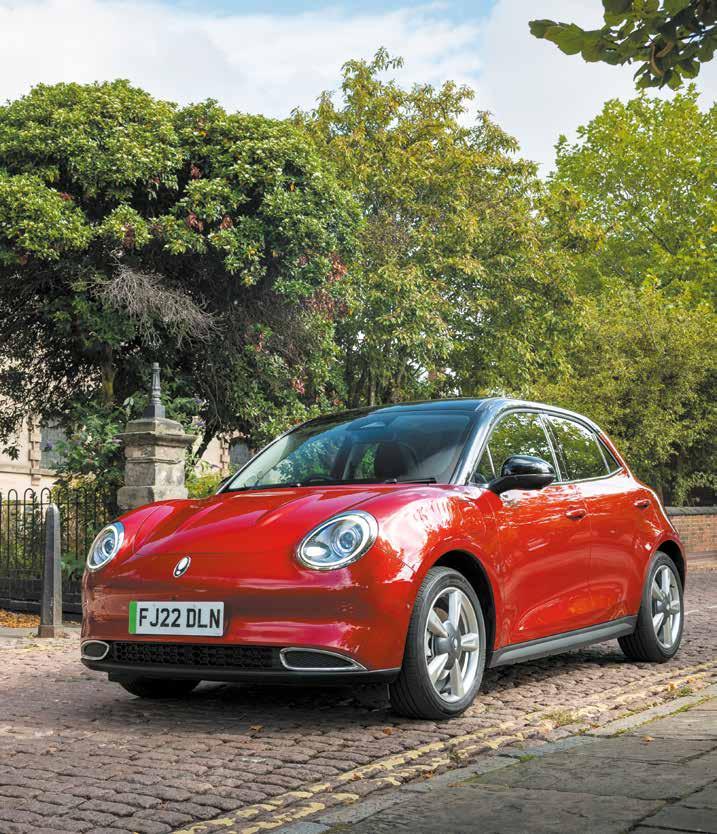

February 2023 • Issue 77 www.companycarandvan.co.uk CAR AND VAN The motoring magazine for SME fleets COMPANY Ora Funky Cat QASHQAI e-POWER Best-seller with clever engine tech JAGUAR F-PACE P400e PHEV offers a 40-mile electric range MAXUS T90 Unique pick-up on test drive ID.BUZZ CARGO Retro looks are causing a stir MG4 is our Car of the Year: Full list of winners inside Exciting new model on the prowl
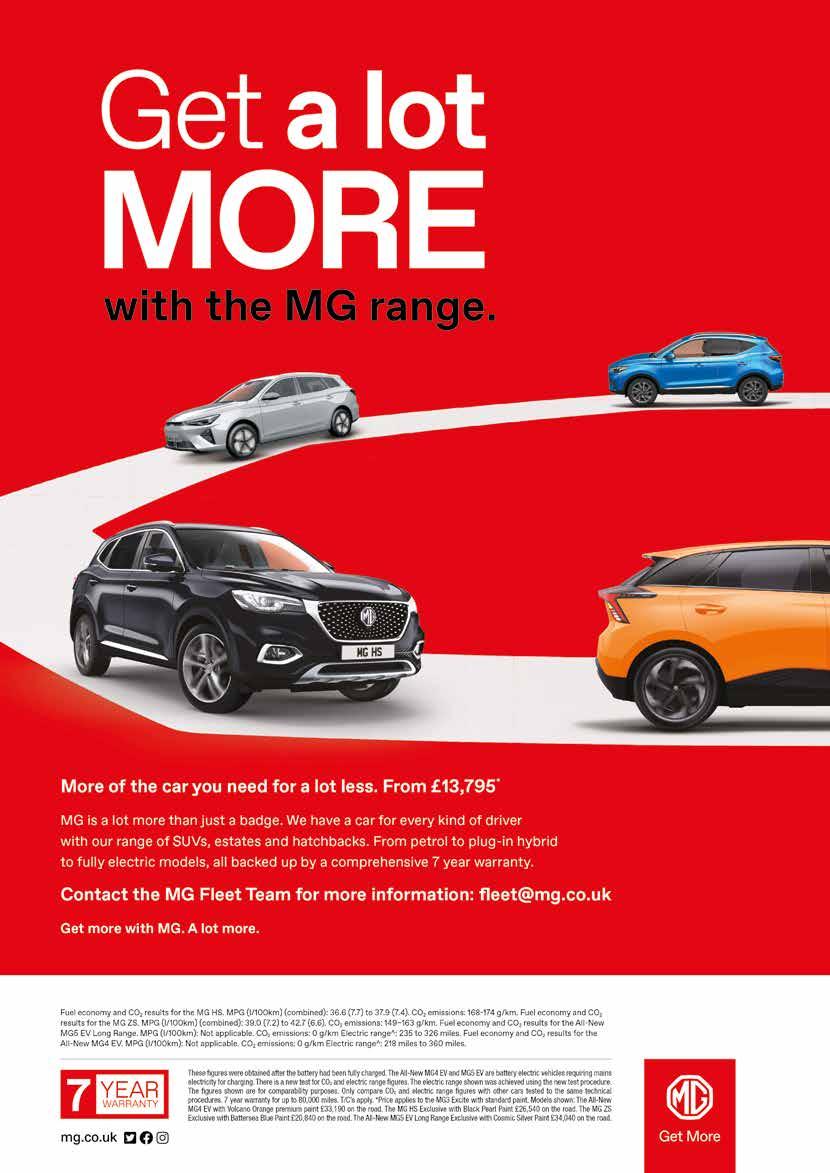
Our February print and digital issue begins with the 2023 Company Car & Van Awards. In what has been another difficult year for the industry, it’s true to say that despite a model supply problem almost across the board, the world’s car and van manufacturers have risen to the challenge and have launched some outstanding new cars, vans and pick-ups. You can read all about our winners from page 4.

Also in this issue, we spent a day driving our cover star, an all-new electric car from a new car brand – the Ora Funky Cat. It’s refreshingly different, as you will see on page 26.
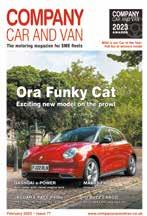
Another electric car that offers SMEs not only low BIK but a low price point is the MG4, which perhaps impressed us the most of any car we drove in 2022.

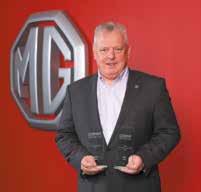
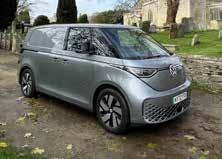
We’ve driven the plug-in hybrid Lexus NX450h +, a serious premium contender, and the Toyota Yaris Cross, possibly 2022’s best small car tested. Plus there’s road tests on the Volkswagen ID.4 and the UK’s best selling car of 2022, the Nissan Qashqai, whose e-Power model very much impressed.
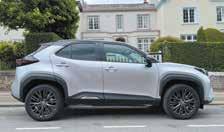
Elsewhere, we have features on the Jaguar F-Pace PHEV, which has just been upgraded, and BMW’s latest EV, the iX1.

On the commercial front, we drove the
exciting Volkswagen ID.Buzz Cargo in November and it certainly caused a stir. The Maxus T90 is the first electric pick-up in the UK and Mercedes-Benz’s eVito now comes with a really useful 162-mile range. Plus there are features on Nissan’s new small van, the Townstar and the new Ford Ranger, which has gone premium.

Finally, we have features on the Chorley Group, a multi-brand dealer group located in the north west, Rolec and Sevadis keep us up-to-date in the charging world, Head-on Electrical takes the electric plunge with an eVito from Northside Truck & Van and Europcar extends its EV rental offering.
Happy New Year!
Andrew Walker, Editor and Publisher
Company Car & Van is wholly owned and published by: Walker Advertising & Marketing Ltd 12 Oakwood Lane, Bowdon, Cheshire WA14 3DL t: 07734 264735 e: andrewmaxwalker@icloud.com w: www.companycarandvan.co.uk Follow us at twitter.com/andrewmaxwalker and www.linkedin.com/in/companycarandvan
every efort is made to ensure the accuracy of material contained within this magazine, the publisher can accept no responsibility for omissions or inaccuracies in its editorial or advertising content. The views expressed in this publication are not necessarily those of the publisher. The carriage of adverts in this publication should not necessarily be viewed as an endorsement of the products or services advertised. All articles within this publication are copyright of Walker Advertising & Marketing Ltd. Editorial consent must be obtained before any are reproduced, either in printed form or electronically. www.companycarandvan.co.uk Company Car & Van | February 2023 | 03 We’ve got award winners galore as we celebrate a host of superb new vehicles Contents 20 44 46 OUR AWARD-WINNING ISSUE MG4 is our Car of the Year Find out why and meet our other winners, from page 4 NEWS Vanaways 16 Sevadis 17 Rolec 18 Europcar 19 CARS Toyota Yaris Cross 20 Jaguar F-PACE 22 ORA Funky Cat 26 MG4 29 Lexus 450h+ 30 BMW iX 34 Volkswagen ID.4 36 Nissan Qashqai e-POWER 38 Chorley Group 39 CV NEWS Nissan Townstar 40 Volkswagen ID. Buzz Cargo 44 Mercedes-Benz eVito 45 Northside Mercedes Benz 46 Maxus T90 48 Ford Ranger 54 04 22 38
Although
Welcome to our award winners
Perhaps we thought that 2022 could only be better than 2021? However, a combination of factors continued to affect the global supply chain of semi-conductors, with manufacturers and dealerships struggling to get new vehicles. It meant that, from an SME fleet perspective, leasing your new car, van or pick-up meant waiting longer for it to arrive. Having said that, plenty did arrive and in the SME fleet sector, the growth of electric sales continued to rise as company car drivers and fleet managers took advantage of low BIK on BEV and PHEV models. Electric newcomers included the Ford E-Transit, Volkswagen ID.Buzz,
Car of the Year: MG4
EVs offer fleet customers such impressive BIK savings that it’s impossible for us not to select an electric car as our Car of the Year. A clear winner this year is the MG4, a well designed and affordable electric car that won’t break the bank. Our judges concluded that plenty of other car manufacturers should take a long, hard look at what MG is doing, because in the short term, it’s cheaper electric motoring that is required. Well done, MG.
Nissan Ariya, Cupra Born, MG4 and Renault Kangoo Van e-Tech. And in a sign of how far electric has come, there was even an electric pick-up, the Maxus T90. New powertrains have been embraced by manufacturers and many models, including the latest Kia Niro, are now offered with petrol hybrid, plug-in hybrid and electric powertrains; perhaps a further sign of things to come?
You’ll see over the following pages that our annual Company Car & Van Awards reflect this, although not every new car, van or pick-up launched in late 2022 arrived in time for us to include them in our judging. Read on to find out who’s won.
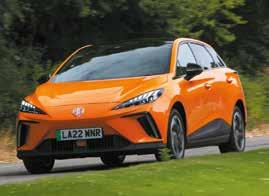

Small Electric Car of the Year: MG4
There are lots of electric cars to choose from, but not many we would categorise as ‘small’. Step forward the MG4, our Small Electric Car of the Year. First and foremost, it looks good inside and out, and it drives really well. Most importantly, the MG4 offers fleet customers a competitively priced entry point into the electric company car sector and a decent battery range. Impressive.
Medium Electric Car of the Year: CUPRA Born
Exciting exterior and matching interior illustrate what Cupra is all about. Compared to most electric cars, the Born’s handling is very good, and the build quality is terrific. It’s also a practical offering, with a choice of two batteries, a good electric driving range and room inside for a family of five. A well deserved win.

04 | February 2023 | Company Car & Van www.companycarandvan.co.uk CC&V AWARDS 2023 www.companycarandvan.co.uk
Geraint Isaac, Head of Fleet Sales MG Motor UK, pictured with the MG4’s two awards
James Jetten, Head of Direct SalesSEAT and CUPRA UK
‘Handling is very good, and the build quality is terrific...’
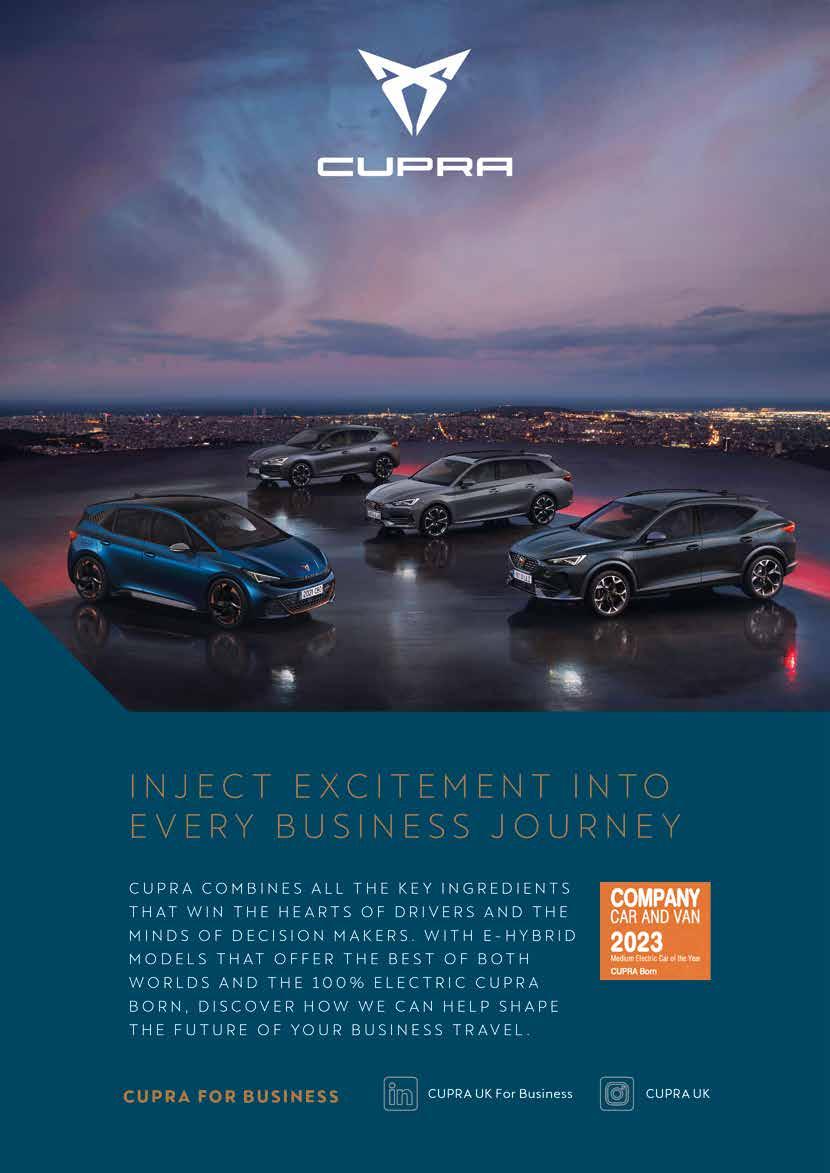
Medium Van of the Year: Vauxhall Vivaro

The Vauxhall Vivaro deservedly retains our title of Medium Van of the Year. All models offer a competitive payload and towing capacity, plus good fuel economy from cleaner diesel engines. On board, the cabin features clever design touches, with all versions getting the latest tech. Add in a nationwide network of Vauxhall Van Business Centres, and van customers need look no further.
Medium Electric Van of the Year: Vauxhall Vivaro Electric

For the second year running, the Vivaro Electric is our Medium Electric Van of the Year. First and foremost it has one of the best electric van ranges and with the same internal dimensions as the diesel Vivaro, offers practical cargo capacity. Furthermore, it comes well equipped, it’s fun to drive and being electric, it’s good for the environment too. If you’re looking for a medium electric van, then the Vivaro Electric should be on your radar.
Electric Pick-Up of the Year: Maxus T90EV
Maxus won the race to get an electric pick-up to market. Utilising parent company SAIC’s battery know-how, it has built not only an attractive pick-up, but a practical one too, coming as it does with a one-tonne payload and 1500kg towing capacity. Factor in a near 220-mile driving range and you have all of the ingredients for success.

06 | February 2023 | Company Car & Van www.companycarandvan.co.uk CC&V AWARDS 2023 www.companycarandvan.co.uk
James Taylor, Managing Director of Vauxhall, with the Vivaro’s award for the Medium Van and, below, the Vivaro Electric
Bill Laidlaw, UK Sales Manager, Harris Maxus, with the CC&V Electric Pick-up of the Year trophy
“If you’re looking for a medium electric van, then the Vivaro Electric should be on your radar...”
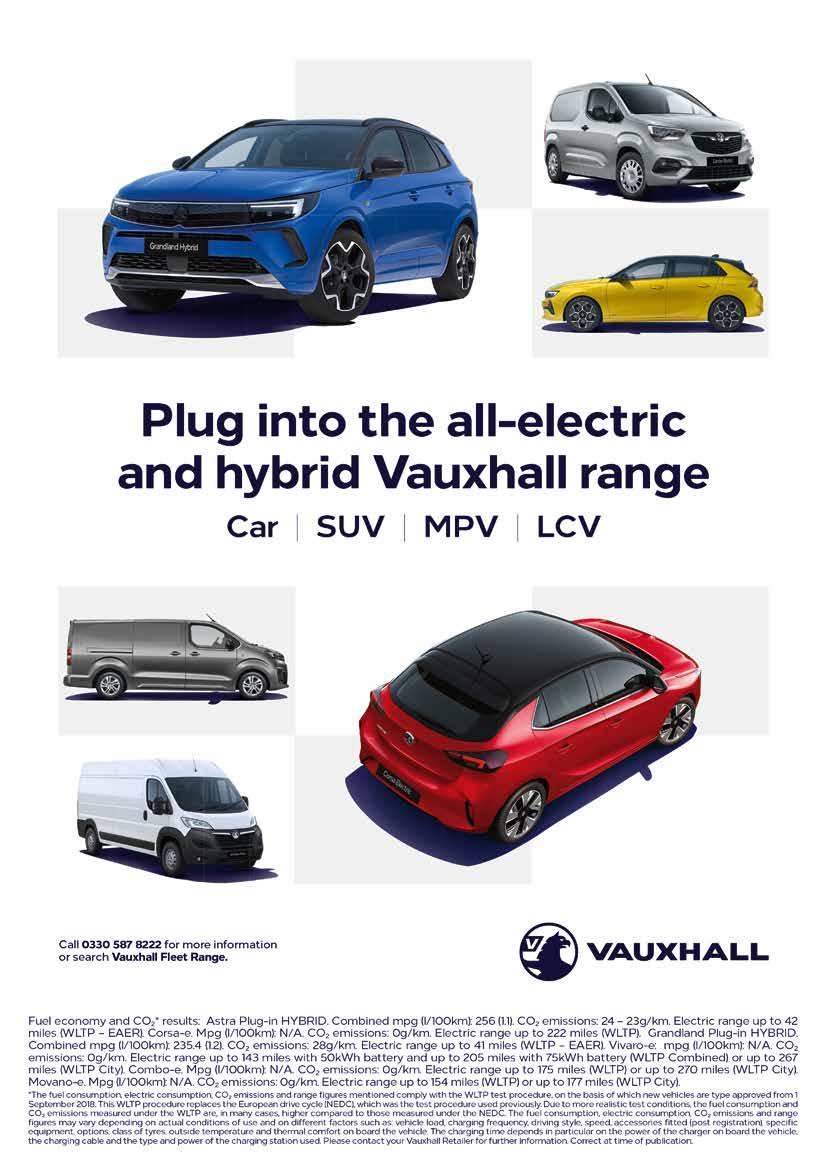
Pick-Up of the Year: Isuzu D-Max

The Isuzu D-Max is our Pick-up of the Year –and for good reason. It features class-leading safety, on-trend tech, a comfortable passenger experience and does what a pick-up is supposed to do: shift goods in tough conditions. Furthermore, it’s available in a myriad of conversions that’s hard to beat and in a range of single, extended and double cab models to suit all customer needs.
Small Car of the Year: Toyota Yaris Cross

The Yaris Cross feels like a grown-up Yaris, with room on board for four adults and a family-sized boot. Decent fuel economy & low CO2’s offer those fleet customers not yet ready for full-electric a reason to lease one. Most importantly, we think it’s a greatlooking car that punches above it’s weight both for practically and price.
Large Car of the Year: Citroën C5 X
We love the way the Citroën C5 X looks, the way it drives and the way it harks back to Citroëns of old. Furthermore it’s a more than viable alternative to a large SUV, offering bags of space with saloon handling and there’s a plug-in too. The C5 X is a breath of fresh air in a sector full of dullness.

08 | February 2023 | Company Car & Van www.companycarandvan.co.uk CC&V AWARDS 2023 www.companycarandvan.co.uk
William Brown, Managing Director at International Motors UK & Ireland, with the Isuzu D-Max
David Crouch, Senior Press Officer at Toyota (GB) plc, with the Yaris Cross
Eurig Druce, Stellantis Network Operations Director, with the Citroën C5 X

Large Electric Car of the Year: IONIQ 5
While the IONIQ 5 doesn’t have a large footprint, it’s spacious interior offers more cabin space than many larger electric cars. It also look fantastic, both inside and out, comes very well equipped and the on-board tech is some of the best out there.
Factor in a real world range of 250 miles and low BIK, and company car drivers should be taking a long, hard look at the IONIQ 5.
SUV Electric Car of the Year:


The Ariya blurs the lines between SUV and Crossover, the two most popular car sectors in the UK, and is our SUV Electric Car of the Year. From outside it looks good, while inside the attention to detail and build quality are excellent.

Furthermore it has a real world range of 230 or 300 miles dependent on battery size, meaning range anxiety for company car drivers will take a back seat.
The Caddy Cargo comes with brilliant build quality, on-trend tech and plenty of safety features. Even with the launch of several new small vans in 2022, it’s still our favourite. If you want a van that leaves you feeling like you’ve been driving a car, then the Caddy 5 has to be your pick.
10 | February 2023 | Company Car & Van www.companycarandvan.co.uk CC&V AWARDS 2023 www.companycarandvan.co.uk
Kate Thompson, Head of Marketing, PR and Communications, Volkswagen Commercial Vehicles, with the Caddy Cargo
Ashley Andrew, Managing Director, Hyundai Motor UK, with the IONIQ 5
Nissan Ariya
Csaba Vincze, Fleet Director, Nissan Motor Corporation:
Small Van of the Year: Volkswagen Caddy Cargo

Small Electric Van of the Year: Renault Kangoo Van E-TECH

We love the Kangoo’s on-trend tech and safety features that come fitted to the new E-TECH, as well as the user-friendly interior and clever storage solutions it offers over its competitors. Add in it’s excellent 186-mile battery range and Renault really is onto a winner with this one.
Premium Electric Car of the Year: BMW i4

The performance is sensational, the handling sublime and the overall quality of the i4 is exceptional. BMW has managed to build an electric car that will offer customers a proper BMW driving experience. With low BIK and a

Premium Car of the Year 2023: Lexus NX
Now offered as a plug-in hybrid in 450h+ guise, the NX ticks every box for company cars. Climb aboard and Lexus’s famed build quality shines through, with this NX a more refined and comfortable car than its predecessor. Lexus has sensibly updated the on-board tech and it now sits at the top table of premium SUVs.

12 | February 2023 | Company Car & Van www.companycarandvan.co.uk CC&V AWARDS 2023 www.companycarandvan.co.uk
Stephen Whitcombe, Head of Brand, PRO+ Commercial Vehicles at Groupe Renault
Steve Roberts, Corporate Sales Manager BMW
David Crouch, Senior Press Officer at Lexus UK
“The 450h+ ticks every box for company cars. Climb aboard and Lexus’s famed build quality shines through...”
‘We love the ontrend tech and safety features...’

Medium Car of the Year: Kia Niro


SUV Car of the Year: Kia Sportage
For company car drivers and fleet managers alike, the Niro comes as a hybrid, plug-in hybrid and an EV, so you are guaranteed a car that works for the way you drive. Both models feature a top-class cabin with excellent safety and infotainment features, with almost all of it standard across the range. Kia can do no wrong at the moment and is producing cars that match every expectation, especially in the company vehicle sector.
Large Van of the Year: Fiat Professional Ducato


How do you improve your best-selling and most successful car? Simple: Don’t fiddle around too much with how it looks, tick. Offer a fleet-friendly plug-in version, tick. Offer loads of goodies even on the cheaper versions, tick. Add a great looking, top notch infotainment system, tick. And build it using higher quality materials than ever before, tick That’s been the Kia philosophy with the Sportage, and it’s made what was a great car even better.
Large Electric Van of the Year: Ford E-Transit.
For the fourth year in a row, the Fiat Professional Ducato is our Large Van of the Year. The latest Ductao was updated at the end of 2021 and now features the latest safety features and tech across the range. Moreover it is also offered in more versions than any other large van and with the option of a nine-speed auto gear box with torque convertor, driving one is easier than ever.
Whoever laughs last, laughs longest, and Ford has certainly laughed last here. While a long time in the making, the E-Transit burst onto the scene and put itself right at the top of the list of the best electric vans money can buy. In addition, the launch of Ford Pro will allow new electric customers to transition to an EV with much less fuss than they’d be expecting, which is another big tick.
14 | February 2023 | Company Car & Van www.companycarandvan.co.uk CC&V AWARDS 2023 www.companycarandvan.co.uk
John Hargreaves, Fleet and Remarketing General Manager, Kia UK, with the trophies for the Niro (this photo) and Sportage (right)
Richard Chamberlain, Stellantis Head of Commercial Vehicles
‘Burst on to the scene and put itself right at the top of the list of the best electric vans money can buy’

Van Sales UK adds Business Development Team to its recipe for rapid expansion

Another foundation stone has been laid as independent vehicle supply specialist Van Sales UK seeks to build a major push for growth in 2023 – with the appointment of Liam Nicholas as its first Business Development Director.
Previously the company’s sales force has concentrated on ‘inbound’ inquiries – taking calls from people looking for new vans and supplying vehicles direct to customers’ premises at the best prices, with the minimum hassle or delay.
Now, in preparation for this year’s anticipated expansion, Liam and his team of five Business Development Executives are taking aim at operators who so far have not used the services of Van Sales UK.
“We’re targeting companies with fleets of 10 vehicles or more,” said Liam. “We believe the quick turnaround and hassle-free service that we can offer is ideally suited to these busy operations, and we want to tell people exactly how we can help keep their businesses running smoothly.”
The appointment of Liam and creation of a Business Development Team is part of a bigger picture. After growing steadily since its
inception in 2017, Van Sales UK has also recently recruited a new Sales Director, Paul Cox, whose stated aim is to increase the number of vehicles sold to 10,000 per year.
Meanwhile, parent company Vanaways has just signed a ground-breaking deal with leading trade and DIY retailer Toolstation, which will market vans through its website, app and network of 550 stores.
Finally, a move to a larger, better-equipped
new office is currently underway.
“There’s a real buzz about the business right now and everyone has an incredibly positive attitude,” said Liam. “We’re all fully focused on providing the best possible customer service because – especially in the fleet market, where operators are replacing vehicles on a regular basis. That’s how we’ll prove we’re worthy of winning and retaining their business.”
• More at www.vansalesuk.co.uk

16 | February 2023 | Company Car & Van www.companycarandvan.co.uk COMPANY NEWS
Leading the charge: Business Development Director Liam Nicholas, right, joins his new colleague, Sales Director Paul Cox, in a drive to send Van Sales UK’s figures soaring
You’ve decided to make the switch: what next?
Sevadis discusses the fundamentals of deciding on an EV charging infrastructure plan for SMEs.
With supply issues continuing to cause delays for vehicle deliveries, businesses of all sizes are either waiting for their fleet of EVs to arrive, or at least, beginning to make the decision to make the electric transition to avoid further delays.
One key element to running a fleet of zero-emission vehicles is how the vehicles will charge – whether that be for a fleet of company cars, or for an operational fleet that contributes to the daily business activities.
Firstly, understanding how many EVs will be on your fleet plays an important role in the decision making process of deploying EV chargepoints at a site: is this number permanent, or will it increase? The latter is commonplace for SMEs that are making the transition to an electric fleet; with the future being electric (taking into account the ban on new ICE vehicles from 2030), businesses are mindful that operational vehicles will all be electric in the future. If the number of fleet EVs increases, businesses will need to consider a futureproofed EV charging strategy in which charging hardware and software are both scalable to fit
the requirements of their wider fleet plans.
Businesses must also take into consideration whether their power supply can withstand demand. EV charging technology has evolved in the last decade, with more hardware and software providers offering intelligent solutions in the form of dynamic load balancing (allowing for charging of EVs without disrupting the site’s power supply, thus mitigating risk), meaning that in most scenarios, adding more EV chargepoints becomes less of a concern. However, for businesses with restricted supply where a large fleet plays a key part in business operations, extending the supply could become a costly option and one that requires further thought for businesses seeking to reduce costs.
When devising an EV charging infrastructure plan, understanding who will be using the charging points, whether that be the board of directors, the staff, the fleet drivers, or even the general public, is also a crucial decision. Under- pinning user-types will allow businesses to calculate costs per user/charging session, as well as allow them to deliberate their return on chargepoint investment. Additionally, deciding on whether the EV chargepoints are operated via a plug-and-play model, or via smartphone or RFID will provide the foundation for which
chargepoint platform/software solution is the most effective.
Whilst the above are crucial elements in determining an EV chargepoint infrastructure plan, user cases do differ. There are a variety of considerations when it comes to EV chargepoint deployment, including who will install the EV charging points; how will data be stored and retrieved; where should the EV chargepoints be located.

For SMEs to benefit from a true EV chargepoint infrastructure strategy, working in collaboration with the EV charging hardware and software providers, as well as the EV chargepoint installer will provide the grounds for a future-proofed solution, benefitting both the EV chargepoint operators and the EV drivers.
For more on Sevadis, visit: https://sevadis.com/

www.companycarandvan.co.uk www.companycarandvan.co.uk Company Car & Van | February 2023 | 17
The Sevadis MaxiCharger Pillar
Rolec EV partners with Sinexcel to bring full range of affordable DC charging units to the UK
One of Europe’s leading electric vehicle chargepoint manufacturers, Rolec EV, has announced a partnership agreement with Sinexcel, a global electric technology company.

The partnership will introduce a new range of cost-effective DC rapid EV charging stations offering speeds from 60kW through to 480kW to support both the future of electrified transport and the nations net zero plans.
Rolec EV already offers the UK’s largest range of AC fast and DC rapid charging points and these latest additions will be the most price competitive in the industry.
The UltraCharge 160 is the first of three models to be introduced and to ensure suitability to the UK market, intensive testing was carried out at Rolec’s HQ in Lincolnshire for over six months.
Having passed with complex testing and compliance procedures, Rolec is now able to confidently charge ahead with deliveries from February 2023.
The modular and scalable ultra-rapid charging station can be upgraded in modules of 20kW, all the way up to 160kW, making it the perfect future-proof and cost-effective solution for public, fleet and highway infrastructure deployment.
Offering convenient charging times for every electric vehicle on the market, the UltraCharge 160’s intelligent dynamic power balancing feature enables two vehicles to charge simultaneously and can be activated via either mobile app, RFID, Apple Pay, Google Pay or contactless card payment as well as conforming to the ISO 15118 Plug & Charge standard.
Frankie Mellon, Rolec’s Sales Director commented: “I am delighted to have formed a strategic partnership with Sinexcel. From the initial discussion Rolec felt we had found a partner who shared the same goals as our own, to excel in customer service, product development and to have a wide product range for all applications at a very costeffective price point.
“We installed the first UltraCharge 160 at our HQ some six months ago now and since that point we have worked extremely closely
ABOUT SINEXCEL
Sinexcel is a leading global electric technology company that energises electricity to achieve a more productive, sustainable future. By developing a power quality, power conversion, EV charger, energy storage and battery formation system, Sinexcel pushes the boundaries of technology to drive performance.
with Sinexcel to further develop the product to meet the requirements of the UK market, integrating with cars, lorries, buses, and to identify features we wished to include as standard for our clients, such as a contactless payment terminal and long reach cables.
“With many workplaces now requiring a DC & AC charging solutions to support fleet, visitor, and employee charging, it is imperative that we can quote and deliver a reliable product with a short lead time to include within our proposal.
“The modular approach of Sinexcel has enabled Rolec to hold UK stock of 60/80/120/160kW models, offering next day delivery to our UK customers. With a 160kW unit retailing at £25,000 we know this product is going to be very well received.”
Charles Meng, Sinexcel’s Country Director commented: “We see the partnership with Rolec as a mutual achievement of our vision for each other. It’s not just a normal partnership, it’s more like entering a formal relationship, like a marriage. After getting to know each other better, we share the same goals together.
Partnership will ensure more accessible DC charging for UK fleets and highways with minimum CAPEX
“Sinexcel saw Rolec’s passion for ‘zero emissions’. The team is professional, precise, efficient and always surprises us, Rolec’s record in EV is amazing, with a deep knowledge of the EV Charging business and always brings us new inspiration.
“The Sinexcel and Rolec EV teams met in Boston to formally confirm what we had in mind for each other. Together, we will move forward to a new chapter.
“We are proud to have such great partners. We are confident that working with Rolec will bring a lot of new changes to the EV Charging business in the UK/Europe.”
ABOUT ROLEC
Rolec Services Ltd is a multidivisional manufacturer, specialising in the EV charging, marina services and leisure industries. With over 30 years of experience in manufacturing outdoor electrical equipment, Rolec is well established within its respective industries for its vast product range and wealth of experience.
18 | February 2023 | Company Car & Van www.companycarandvan.co.uk EV CHARGING NEWS www.companycarandvan.co.uk
Building a future-proofed fleet strategy
Champions of EVs would have been celebrating when the 2022 new vehicle data was released by the SMMT at the start of January, showing that electric vehicles overtook diesel in new sales for the year. But it’s important not to mistake that landmark as signalling that all is rosy on the decarbonisation journey.

Vehicle supply remains a challenge. Plus, recent Europcar research found that over 40% of motorists surveyed do not agree with the end to the exemption of vehicle excise duty in 2025. Combined with the cost-of-living pressures affecting businesses and individuals this could well dampen take-up of EV in the near future.
There’s no question, however, that it’s the corporate fleet sector where the growth in EV is expected. Indeed, the 2022 SMMT data underpins the role of business buyers. While private motorists accounted for more than half of all new vehicle registrations, fleets and business buyers were responsible for the lion’s share of battery electric vehicles, accounting for two-thirds (66.7%) of all BEV registrations and 74.7% of the volume gain in 2022.
A transition
But there are still so many ‘unknowns’ about electric motoring. So the key now is for those responsible for business vehicles – whether it’s
just one or two or hundreds – to truly understand what’s the right fit for right now – as well as planning for the future. Businesses are keen to ‘try before they buy’ to really understand what electric motoring means in real world conditions. They are also keen to ensure the transition to zero doesn’t have any short-term negative impact on operations and business costs. Plus they need to manage immediate vehicle needs as fleets get older while they wait for new vehicle supply.
For all of those reasons making a steady switch, moving from older, higher polluting vehicles to low emissions and eventually to zero, is the common-sense approach being adopted by many businesses.
Supporting the sustainability journey
From low and zero emissions cars and vans to flexible on-demand vehicle solutions Europcar is helping organisations develop

robust environmental policies for present and future operations. We’re also focused on offering attractive alternatives to vehicle ownership for those organisations not yet ready to move to zero.
Renting ICE vehicles when needed, rather than owning, naturally reduces mileage and the resulting environmental impact. And if the vehicle is chosen to match the needs of a specific journey, this increases efficiency and reduces unnecessary emissions from driving too big a vehicle.
And for new EV adopters, Europcar is offering a rental solution for electric that gives businesses the chance to assess the operational and commercial impact of electric vehicle use and to satisfy driver concerns. Available with no upfront deposit and commitment free, Europcar solutions for electric vehicles include a detailed vehicle handover and advice on charging as well as the option for CO2 reporting for valuable insight into emissions. Plus the Shell Recharge card and app provide access to over 10,000 publicly accessible charge points across the UK. • To find out more about how Europcar can help your organisation on your decarbonisation journey, visit www.europcar.co.uk/business/electric or call 0371 384 0140.
LEASING www.companycarandvan.co.uk www.companycarandvan.co.uk Company Car & Van | February 2023 | 19
Head-turning Cross adds touch of muscle to the Yaris range
Sense, Toyota Touch 2 multimedia system with 8” touchscreen, DAB, Bluetooth, six-speaker audio system, Smartphone integration with Apple CarPlay and Android, AutoSmart entry, push-button start, a reversing camera, auto air con and a 4.2” multi-information display.
Sign Assist and Automatic High Beam.
Yaris Cross also come with eCall which can automatically summon emergency services assistance in the event of a serious impact.
Engine, performance and economy
Toyota’s Yaris family – supermini and hot-hatch – now has a small SUV option, with the arrival of the Yaris Cross. Think Yaris on steroids.
As you might guess from that description, it’s quite a bit larger than its supermini brethren, and is almost as spacious inside as the larger CH-R. It offers company car drivers tax-friendly CO2 emissions from 102g/km, and CC&V got to grips with one recently.
What is it?
Built on the same TNGA platform as the other Yaris models, it’s powered by a 1.5-litre three-cylinder petrol engine with a CVT transmission. The front axle features an electric generator and motor that gives the Cross it’s hybrid powertrain.
As a whole, it’s 240mm longer than the standard Yaris, with 60mm added to the front and 180mm to the rear. The ground clearance is 30mm higher and the vehicle is wider and taller overall by 20 and 90mm respectively.
Model range and spec
There are four model choices available, beginning with Icon as the entry model, then Design, Excel and finally Dynamic.
All come generously equipped with Icon offering 16” 10-spoke alloys, Toyota Safety
To this equipment the Design adds 17” dark grey/machined five-double-spoke alloys, LED projector headlights, rear lights and sequential indicators, light blue ambient cabin lighting, aluminium roof rails, black headlining, a 7” multi-information display and rear privacy glass.
Excel enhances this further with the addition of 18” dark grey/machined five-triple-spoke alloys, a power tailgate with kick sensor, 9” Toyota Smart Connect multimedia system, Blind Spot Monitor, Rear Cross Traffic Alert with auto brake, intelligent parking sensors, a heated steering wheel and front seats, an auto dimming rear view mirror and dual-zone climate control.
Finally, the range-topping Dynamic offers a more distinctive SUV appearance and can be specified with front or all-wheel drive.
It features, in addition to the Excel trim level, 18” dark grey five-triple-spoke alloys, a bi-tone paint finish with black roof and the option of intelligent all-wheel drive. All-in-all, it’s an equipment level to rival those of its rivals.

Safety
All Yaris Cross models benefit from Toyota Safety Sense active safety and driver assistance systems as standard.
The package includes a Pre-Collision System with pedestrian and cyclist recognition and Emergency Steering Assist; full-range intelligent Adaptive Cruise Control; Lane Departure Alert and Lane Trace Assist; Road
We were testing the Dynamic model, which features a three-cylinder 1.5 hybrid engine, which comes with 114bhp, with the electric motor producing up to 79bhp. Top speed is 105 mph; 0-62mph IS 11.2 seconds. Fuel consumption is a claimed 54.6- 56.5 mg, with CO2 emissions of 112-117.2 g/km.
Interior
The cabin features plenty of black, grey and chrome and is unmistakably a Toyota. Quality is good, with decent materials used throughout and solid, straightforward switchgear.
The dashboard is dominated by the touchscreen, which is a huge jump up in quality for Toyota compared to previous tech used. It features clear graphics and fast response. Underneath the touchscreen sit narrow air vents and separate climate controls, with a single USB input. Located between the front seats are the gear stick, electric hand brake, Drive and EV mode buttons.
Practicality
The 397-litre boot features a heightadjustable luggage deck which can be divided in two. The luggage compartment also has a new flexible belt system to keep items secure when driving.
The cabin feels more spacious than the larger Toyota CH-R and comes with a glove box, centre cubby, under armrest storage, four
20 | February 2023 | Company Car & Van www.companycarandvan.co.uk ON TEST: TOYOTA YARIS CROSS
Toyota has added an SUV option to the Yaris –and it has plenty to offer, as Andrew Walker discovered...
small door pockets and a couple of drinks holders located between the front seats.
The car’s extra length is most noticeable in the cabin, with those in the front seats spoilt for both head and legroom. The rear seats will take three and there is good headroom, though you may struggle for legroom if behind a tall driver. The extra 25mm of height gives the driver a decent driving position.
Driving modes and economy

In common with many hybrids, the Cross will drive in EV mode up to 30mph, at which point the petrol engine will kick in. There’s a default driving setting, plus Eco, Power, EV and B, instigated by pulling the gear stick all the way towards you, which increases the regenerative braking effect.
We tried them all out, sticking to Eco mode on the motorway and utilising EV mode and B in town on slower, local routes. Power gives you a little bit more oomph when joining a motorway. A week and 300-miles driven, 200 of which were on the motorway, saw us average 55.3mpg.
On the road
The Cross’s small stature means it feels nippier than it actually is. City streets are its bread and butter and the chassis and wheels coped well with the pot-holed and worn-out tarmac locally.
Put your foot down and you may notice the CVT gearbox groaning a little. However, once you are up to speed the Cross will sit quite happily at motorway speeds.
The on-board Adaptive Cruise Control, Lane Departure Alert and Lane Trace Assist work well on the motorway but are best turned off for town and country driving.
Talking of the motorway, we tended to set the cruise at 70mph, sit back, relax and let the Cross do the work for you.
My travel companions had no complaints about the car’s ride or any excess cabin noise upsetting their journey, and the bonus of a decent sized boot meant that I was able to transport four adults plus bags to a local tennis match in some comfort.
Overall, the Cross won’t set your pulse racing, being more of a solid performer than a superstar. But its light, positive steering and decent road handling are stand out features that make it an enjoyable car to drive. EV mode will take you a good 30 miles if used carefully and we reckon that if we hadn’t been bombing along the M6 for 200 miles, we could easily have achieved 60+ mpg.
Pros
It looks good from every angle and also all versions come very well equipped. Highlight is the much improved infotainment system over Toyotas of old. From a practical perspective, it
feels at least as spacious inside as the larger CH-R and it’s easy to drive. Long journeys were comfortable and the Yaris Cross offers good fuel economy and low CO2 emissions.
Cons
We still don’t like the CVT gearbox, although we will concede that it does work better in smaller Toyotas. The exterior looks are striking but all those sharp angles won’t appeal to all. The interior is little bland.
Conclusion
You won’t be disappointed. The Cross feels like a grown-up Yaris, with room on board for four adults and a family-sized boot. Decent fuel economy and low CO2 gives fleet customers not yet ready for full-electric an opportunity to save some money. Most importantly, we think it’s a great looking car that punches above its weight on practicality and price.
CC&V VERDICT
Economical motoring for those not ready to go full EV just yet. Great in the city and you’ll love the space on offer inside.
CC&V RATING: N N N N N
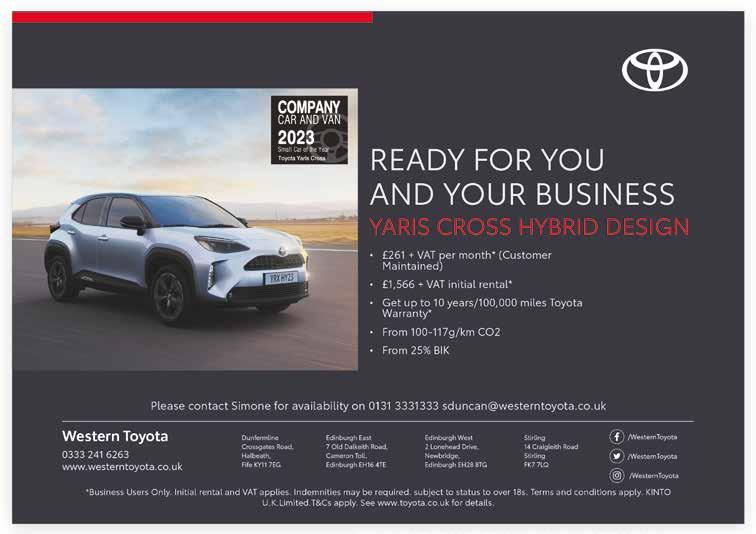
www.companycarandvan.co.uk www.companycarandvan.co.uk Company Car & Van | February 2023 | 21
The Jaguar F-Pace has been given an upgrade, with a bigger battery pack for the P400e PHEV and an improved interior. With 20 per cent of current UK F-Pace sales being plug-in, predominantly in the fleet sector, it’s a chance for the new P400e to increase its market share in a very competitive sector.
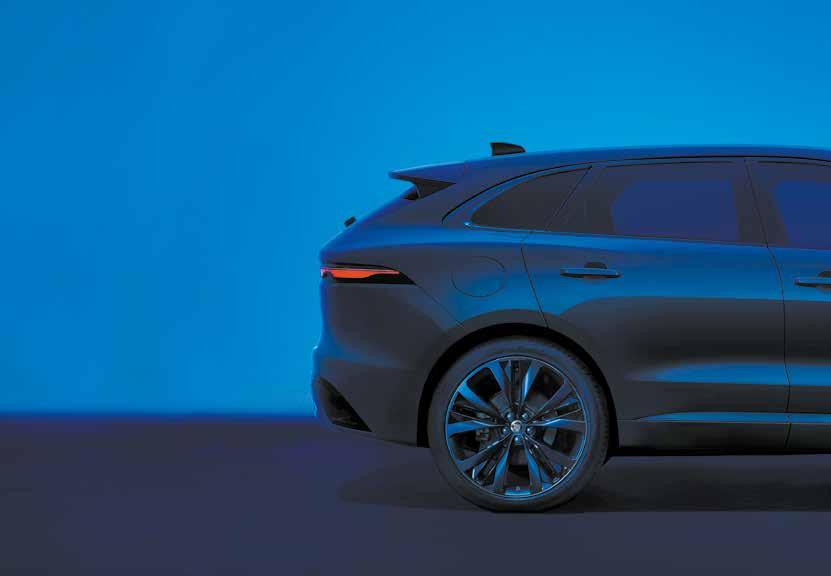
For company car drivers the big news is the plug-in’s increased electric range, up 20 per cent from 33 to 40 miles. This is thanks to a larger lithium-ion battery, which now comprises of nine modules instead of eight, increasing energy storage capacity to 19.2kWh and resulting in an electric-only driving range of 40 miles.
Furthermore both C02 emissions, now 37g/ km, and fuel economy – 176.6mpg – are better too, although the car’s powertrain, all 404bhp of it, will still entertain taking you from 0-60mph in just five seconds.
Simplified model range
The 2024 Model Year F-Pace range now comprises: R-Dynamic S, R-Dynamic SE Black, R-Dynamic HSE Black, 400 SPORT and SVR. F-Pace SVR is Jaguar’s pinnacle performance SUV. Powered exclusively by Jaguar’s 550PS
5.0-litre V8 supercharged petrol engine, it is capable of accelerating from 0-60mph in 3.8 seconds and can reach a top speed of 178mph.
The powertrain range comprises 404PS four-cylinder petrol PHEV, 250PS four-cylinder petrol, 204PS MHEV four-cylinder diesel, 300PS six-cylinder diesel MHEV, 400PS six-cylinder petrol MHEV and 550PS V8 petrol with all F-Pace models feature intelligent all-wheel drive & eight-speed automatic transmissions
Higher specced models
MY2024 F-PAce now features enriched specifications: R-Dynamic S models now feature a Digital Driver Display & 19” wheels as standard, while R-Dynamic SE Black and above now all feature Interactive Driver Display with an Ebony Suedecloth headliner as standard
Improved connectivity.
JLR’s Pivi Pro infotainment now includes integrated Alexa voice control2 and what3words2 navigation, as well as wireless Apple CarPlay® 2 & Wireless Android Auto™2 as standard
Upgrades to model range
The R-Dynamic S, SE Black and HSE Black models are equipped with 19, 20 and 21” wheels respectively, and are offered with a choice of diamond-turned or black finish (all available with optional self-sealing tyres), while the 400 SPORT now has an increased wheel size as standard, offering 22” forged wheels – Style 1020 in Gloss Silver with diamondturned finish and contrast inserts.
The centre caps on all are now black and silver in place of the previous red and silver.
F-PACE’s assured, dynamic presence is heightened still further with the Black Pack –now standard on all models from the R-Dynamic SE Black through to the SVR – and which now has the Gloss Black finish applied to the door mirror caps as well as the grille, grille surround, window surrounds, fender vents, rear valance and rear badges.
Another subtle change is the R-Dynamic grille badge updated to a contemporary black and grey instead of red & green.
Prices
Prices start at £48,660 for the D-200 R Dynamic 2.0-litre diesel F-Pace, with the P400e
22 | February 2023 | Company Car & Van www.companycarandvan.co.uk NEWS: JAGUAR F-PACE
F-PACE: all the pleasure of a Jaguar, with the tax benefits of an plug-in
PHEV priced from £69,280. We drove the current F-Pace PHEV last November and really enjoyed the experience. The improvements will make it more appealing in the corporate sector, especially the extra 7-10 miles of electric-only range.
Conclusion
While the P400e isn’t cheap, its company car
tax saving credentials are the real winners here. The cabin is comfortable and spacious and much improved over the original F-Pace. Only the smaller boot space over the ICE versions is a compromise.

Furthermore, if you’re looking for a large SUV that’s great to drive, will return close to 40mpg, and undercuts similar offerings from Germany on price, it’s well worth considering.
The tax savings are the real winners here... and it’s a large SUV that is great to drive, returns close to 40mpg and undercuts similar offerings from Germany... well worth considering

www.companycarandvan.co.uk www.companycarandvan.co.uk Company Car & Van | February 2023 | 23
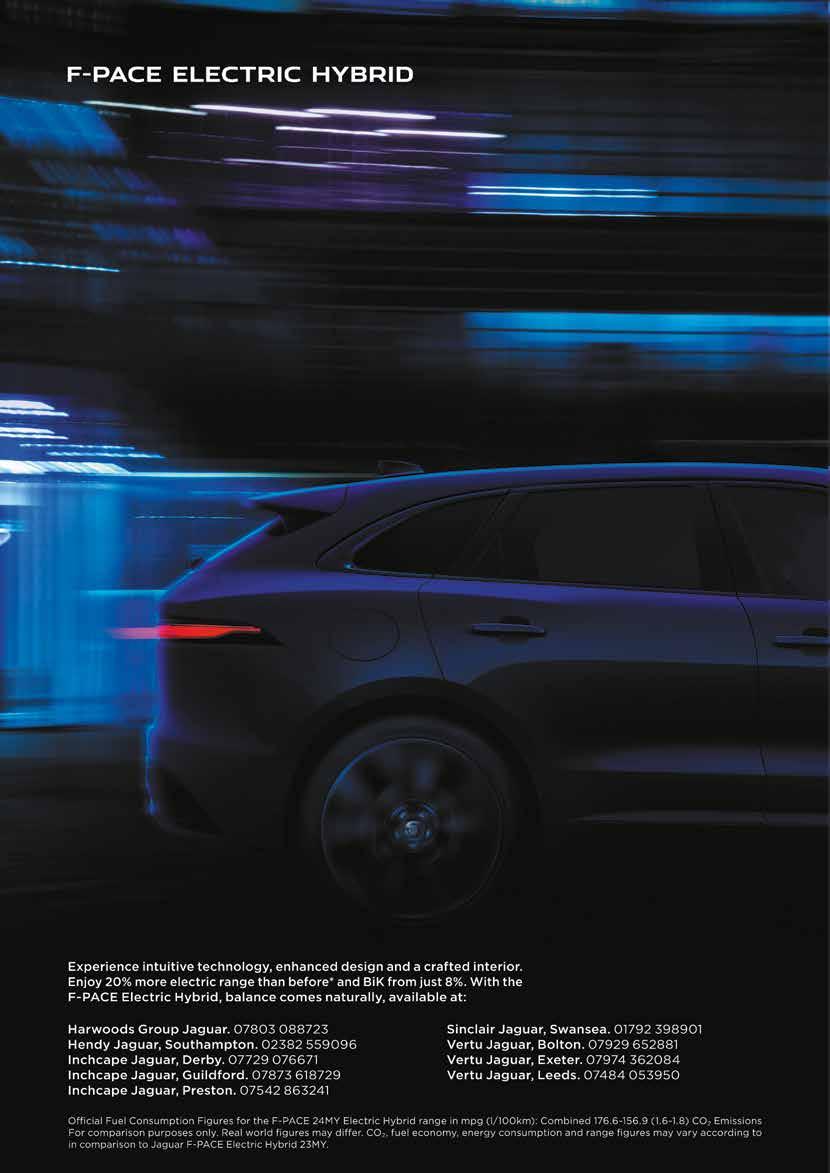

ORA Funky Cat’s on the prowl
There’s a new cat in town: the ORA Funky Cat, a new electric car from China. Built by Great Wall and distributed by International Motors in the UK, ORA is the brand’s EV arm and the Cat is the first in a range of electric cars the brand is launching over the next few years.
Model range
As a new brand franchise in the UK, ORA is sensibly limiting your choice of Cat to one powertrain, a 48kWh 250Nm battery, and one spec, the First Edition. There’s also a limited choice of colours, with just four from launch; Aurora Green with a white roof, Mars Red with a black roof, Starry Black and Nebula Green.
Price
It costs from £31,995 on the road. Metallic paint adds £595, metallic paint and dual tone interior – our test model featured strawberry and cream – adds £795.

Performance and range
The 48kWh battery offers peak power of 126kW with 171PS. Acceleration from 0-62mph takes 8.3 seconds. Top speed is 99mph. WLTP electric range is 193 miles.
Exterior
The Cat is an amalgamation of a number of cars. The headlights are Mini, the curved bonnet Beetle-esque, the side Nissan Leaf and the rear hatch very much ORA’s own design, with its full width LED brake light, narrow rear window and large ORA lettering.
Interior
ORA Funky Cat hails from China and you may have some pre-conceptions about the build quality. Trust us, it’s actually very good and definitely higher than the quality you’ll find in the Chinese-built MG range, and it’s as good as the levels you’ll find on Japanese and Korean brands.
High-quality soft-touch plastics feature on the dashboard, glove box front, door panels and centre console. The retro chrome switchgear underneath the touchscreen is a nice touch, as is the steering wheel finish – our test car had a cream and black design. There’s a rotary gear selector, with the electric handbrake behind, twin USBs, a 12v socket and First Edition logo
just above. The quilted seat finish continues on to the top of the door controls and there’s a padded armrest with underneath storage.
Safety
The Funky Cat features some serious protection. There’s an ADAS safety package that includes Adaptive Cruise Control, Lane Keep Assist, Lane Centring, Rear Cross Traffic Alert, Junction Assist and Auto Emergency Braking with pedestrian and cyclist detection. And driver, passenger airbags and side airbags, curtain airbags and even a centre airbag are also standard.
Specification
First Edition features quilted leatherette seats which are electrically adjustable in the front. A 10.25” infotainment display, wireless phone charging, SatNav, DAB, Bluetooth, keyless

entry and start, rear parking sensors, a reversing camera, with both facial and voice recognition, a first in the class. Apple CarPlay and Android Auto also feature.
If that’s not enough, the Funky Cat also gets 12 ultrasonic radar sensors with multiple exterior cameras that monitor the car’s surroundings. The information gathered is then processed by the latest Qualcomm Snapdragon computing chip, which allows for semiautonomous driving and on the screen in front of the driver, as with those found on Teslas, you get a map of vehicles and other road users to help you navigate.
Charging
At home on a 7kWh charger, like our own Rolec, https://www.rolecserv.com/ev-charging, it will take 5.5 hours to fully charge your battery. On a public 11kWh charger that drops to three hours 12 minutes, or on a public 100kW fast charger, just 43 minutes.
Our advice, as ever, is charge at home at night when electricity is cheapest.
Practicality
The Funky Cat cabin is surprisingly spacious, helped by the battery spread evenly under the floor plan. Six-footers will be comfortable in front or the rear, although the centre rear seat is best used for shorter journeys or young teens. The boot is deep but only offers 228 litres of space, with ORA prioritising cabin room over luggage space.
Fold down the 60:40 rear seats though and a useful 858 litres is on offer.
Crazy name – but is it good to enough to get the hackles up on the opposition?
Andrew Walker checks out the ORA Funky Cat
26 | February 2023 | Company Car & Van www.companycarandvan.co.uk ON TEST: ORA FUNKY CAT
Warranty
ORA is generous here with a five-year unlimited mileage warranty, eight-year or 100,00 mile EV battery and EV powertrain warranty, five years or 60,000-mile paint warranty and a 12-year anti-corrosion warranty.

On the road
Even with a battery at 48kWh, which is smallish for an electric car, the Funky Cat weighs in at 1,970kgs, so this is going to affect the way it drives and handles. Climb in, select drive (for the Cat’s engine starts automatically) and away you go. All is quiet and serene as you motor through town. While the Cat’s ride is on the firm side it’s not uncomfortable and by utilising the built-in regenerative braking you can increase the braking power to top up your battery.

There’s also a driving mode sector located down to the right and partially hidden by the steering wheel. Here you can further enhance your Cat’s economy by choosing Eco mode, or select Normal or Sport modes too.
On the motorway, the Adaptive Cruise Control can be selected via a stalk on the left of the steering wheel. You can’t actually see the stalk but it is simple to work. Cruising along at motorway speeds the only noise entering the cabin is from the car’s 18” alloy wheels. We had set up the ORA to Bluetooth on our iPhone and were able to listen to a favourite podcast as we motored along. Like other electric cars,
when you’re on the motorway, the inclusion of Adaptive Cruise Control takes the thinking out of driving it, making the Cat an enjoyable cruiser at high speeds. The squat shape and size of the Cat means it’s good fun in corners and if you push hard, it feels confident.
We’ve mentioned that firm ride, something that plagues all electric cars, but it’s really not an issue as the comfy, padded seats offer decent support.
Did we have any issues? Not with ride, nor the acceleration or with the cabin ambience. But the indicators are sensitive and any firm
push up or down sets off the opposite indicator and it took us a good few minutes to work out that you need to lightly touch them up or down for them to stop. Furthermore, the car’s infotainment is not the easiest to navigate. Much of it goes through the touchscreen and some of the menu headings are confusing. Software designers appear to have been let free on the Cat. We’re sure that given time, it becomes easier to use –though we have to say, this is the case with all car brand’s systems nowadays.
Continued on page 28
www.companycarandvan.co.uk www.companycarandvan.co.uk Company Car & Van | February 2023 | 27
Continued from page 27
Pros
Exceptionally well built, very, very, well equipped and supremely safe to be in. It’s also refreshingly different to look at with some neat and tidy retro touches inside.
The on-board tech is second to none. From a company car perspective the 2% BIK makes the Cat a winner from the get go.
Cons
With only one 48kWh battery offered, the driving range isn’t fantastic and is bettered elsewhere. There’s only four colour options. The infotainment systems is a little fiddly and the indicators a little too sensitive.
Compared to the competition, ID.3 and Cupra Born, the boot is small.
Conclusion
ORA may be new here in the UK, but we think that the marque is off to great start with the Funky Cat. Initially we were surprised at the cost: after all, its £7,000 more than an MG4. But rest assured, build quality and design-wise, it’s definitely aiming higher than the MG.
More good news is that the tech and safety that feature on Funky Cat is some of the best out there and should satisfy even millennial techies who are looking to drive electric.

As far as battery range goes, if 193 miles
isn’t enough for you, ORA will be bringing a larger 63kWh battery Funky Cat model to market later this year, with a range of up to 261 miles.
And finally, it’s great to see a new electric car come to market. In the case of the Funky Cat, it’s tried to be different, with a new take on a name and a car aimed at attracting a new customer to the electric world.


All hail the Funky Cat!
CC&V VERDICT
New name but don’t be scared about that: this is a well put together, well-specced model that will grab attention. Range is average but a bigger battery is on its way
CC&V RATING: N N N N
28 | February 2023 | Company Car & Van www.companycarandvan.co.uk ON TEST:
www.companycarandvan.co.uk
ORA FUNKY CAT
MG cracks it with the MG4
MG4 is the brand’s first EV built from scratch. Andrew Walker got to grips with it recently and came away impressed.
MG4 is competing with the likes of the VW ID.3 and Cupra Born in the small-medium EV sector and delivers better balance, driver experience and road holding than those rivals. The battery powers a rear-mounted motor that produces up to 200bhp with a rear wheel drive configuration.
Models and battery range
There are three models available, with two batteries: the SE Standard Range (from £25,995); the SE Long Range (from £28,495) and the Trophy Long Range (from £31,495). Initially the SE Standard Range has a 51kWh battery, with a larger 64kWh battery on SE Long Range and Trophy Long Range.
The Standard Range has a 218-mile range on the WLTP cycle, and the Long Range SE and Trophy offer 281 and 270 miles respectively. The 64kWh battery charges from 10% – 80% using a 150kW DC rapid charger in 35 minutes. With a home 7kW wallbox the same charge takes about eight hours to full on the 51kWh battery, or 10 hours for the larger 64kWh battery.
Inside it is step up from previous MGs. There’s good interior cabin space and a 363-litre boot, but at such a competitive price, some of

the plastics lower down are a little harsh. Better are the dash front and top, ‘Allegro’ hexagonal steering wheel and infotainment screen, which are nicely finished and are softer plastics. The interior is fairly sparse with a floating ledge for the gear selector, but it does leave storage space below. Up front, there’s decent head and leg room, and rear leg room is fine. However, the swooping roof line eats into rear head room.
While most will focus on getting the best battery range, it’s worth noting that the MG4 has a 0-62mph time of 7.7 seconds, with EV oomph from take off. Drive in Eco and the car dulls

things down a bit, Medium feels swifter and Sport improves feel and steering slightly.
Where the MG4 most surprised us was its agility. Whether this is to do with the thin battery, the 50:50 weight ratio or lightish components, or a combination of them all, it’s a nimble and enjoyable companion, something most electric cars still struggle with.
In town it’s quiet and light, while on the open road it handles well. It’s an impressive electric car within a relatively tight budget that should be on company car drivers’ shopping list.
CC&V RATING: N N N N N
ON TEST: MG 4 www.companycarandvan.co.uk www.companycarandvan.co.uk Company Car & Van | February 2023 | 29


Lexus NX450h+ is welcome entry to the premium PHEV party
 Andrew Walker
Andrew Walker
The Lexus NX was originally launched in 2014 and quickly became the brand’s most popular car. However, when the NX was updated, Lexus didn’t offer a plug-in hybrid or full electric version, but this all-new model put that omission right.
For those who don’t know, the NX is a five-door SUV, powered by either a 2.5-litre self-charging petrol in FWD or AWD or a 2.5-litre plug-in hybrid petrol engine. Both feature a CVT gear box.
You can choose from the self-charging NX 350, with starting price of £39,760, in Sport or Takumi trim, or the plug-in NX 450h AWD + in Premium, Premium + or Takumi trim. The entry level of the 450h is £50,950 so it’s quite a big jump, price-wise, from the cheapest self charging version.
Our test was in the most fleet-friendly model, the NX 450h+, and the specs here are based on the plug-in version only.
Equipment
All plug-in hybrid NXs feature wireless smartphone charging, a reversing camera, dual-zone climate control, heated seats, LED headlights, keyless go and the ‘Lexus Safety System+’. The main interior change is that Lexus has got rid of the infotainment track pad used on the previous NX, replacing it with a smarter, simpler and cleaner touchscreen. Entry-level NX 450h+ features a 9.8” central touchscreen, while F Sport and Takumi trims get the larger 14” version and 10” digital driver’s display. Wireless Apple CarPlay and wired Android Auto are also included and overall, it’s a massive improvement over what came before.
Engine and company car benefits
The 450h+ shares its TNGA-K underpinnings with the latest Toyota RAV4. This hybrid system comprises a 2.5-litre four-cylinder petrol engine with CVT transmission, tagged to an 18.1kWh battery and electric motor. Lexus says that 43 miles is possible on battery power alone. For fleets, the CO2 is as low as 20g/km which equates to just seven per cent in BIK and big tax savings for its fleet drivers.
Fuel economy and performance
Lexus claims combined economy to be as high as 256.8 mpg and, if you only ever drive your NX locally for 20 miles per day, that is possible. However, take a longer trip and this will drop. For example, in our test week, by utilising the electric range until we reached the motorway and plugging the NX in to charge
overnight, we drove the 450h + over 200 miles in a week and averaged 58.7 mpg, which is still impressive.
With 302bhp, top speed is 124mph and 0-62mph takes just 6.3 seconds, which isn’t bad at all.
Exterior and interior
The latest NX is 20mm longer and comes with a 30mm longer wheelbase. Outside it’s less angular than the previous version, with slim LED headlights and the familiar Lexus spindle grille. At the rear, there’s now a full-width tail-light and overall the cars shape and lines feel simpler, cleaner and more pleasing on the eye.
The first thing you’ll notice inside is that the dash and cabin feel less cluttered. We’ve already mentioned the new touchscreen, which is excellent. You still have separate climate controls sitting beneath the touchscreen, but in

effect, there’s actually half as many buttons as on its predecessor and mirroring the outside, it feels more modern and on-trend, too.
The quality you expect from Lexus is still there though, with all surfaces brilliantly put together and all finished in a mix of high quality and soft touch plastics. Our Takumi test car also featured leather upholstery with heated front and rear seats and an extra with a sunroof.
Boot space and cabin practicality
Front seat passengers won’t be disappointed by the head and leg room on offer in the NX 450h+. You also get a decent-sized glovebox, twin USB ports, large door bins, twin cup holders, a cubby under the armrest and space for your phone with wireless charging.
The extra 20mm length of the latest NX makes quite a difference to rear legroom, although the centre rear passenger still has to contend with a transmission tunnel. Head room is good as well. Rear passengers also benefit from twin USBs and a fold-down armrest with two cup holders.
Both the self charging and plug-in NXs offer 545 litres of boot space. Fold the seats down and you get 1,436 litres of load capacity. The boot finish and carpet used are exemplary and there’s the added bonus of space underneath the useful flat floor to hide the charging cable.
Driving modes
The NX 450h+ features three driving modes: Eco, Sport and Normal. All three are accessed
32 | February 2023 | Company Car & Van www.companycarandvan.co.uk ON TEST: LEXUS NX450h+
TECH DATA
Model Tested: Lexus NX 450h+ Takumi

OTR Price: £61,200
Engine: 2.5-litre 4 cylinder petrolelectric plug-in hybrid Power: 302bhp
Transmission: CVT auto 4WD 0-62mph: 6.3 seconds
Top speed: 124mph Economy: 256.8mpg
CO2: 26g/km
BIK: 7%
via a knob in front of the gear lever. Twist for Eco or Sport, push for Normal. You can maximise your battery range by utilising the EV save mode button next to the electric handbrake. This means that you can save your electric range for when it’s most economical, low-speed urban driving.
Furthermore, the plug-in does also offer some other range-saving aids. For example, you get the bonus of battery-assisted driving in the hybrid drive modes. When the battery is fully depleted, the NX reverts to being a normal hybrid. So you still get electric assistance at low speed, which adds to the economy.
On the road
Perhaps unsurprisingly, if you take the NX on to the motorway, you’ll have little to complain about. The built-in radar-controlled cruise control is simple to work and the plethora of


third-generation Lexus safety systems, such as Lane Keep Assist, Lane Trace Assist and Front Cross Traffic Alert, make it one of the safest cars you can own.
Cabin noise is minimal and all passengers will enjoy the cosseting, comfortable seats. Our only complaint is that when you push down hard on the accelerator pedal, the CVT gearbox whines as it spins into action and this can be heard in the cabin.
In town we were able to make use of the car’s pure electric range and managed four days of local driving before we needed to plug in. Talking of which, charging on our 7kWh Rolec Smart Charger, the NX’s 18.1kWh battery took between 2.5 and 3 hours to charge from empty. When our Octopus Go night time rate between 00.30 hrs and 04.30 hrs is just 7.5p a kWh, we could replenish the NX’s battery for just 20p, and as we were seeing a pure electric range of 32 miles, that’s cheap motoring and another feather in the cap for Lexus’s first plug-in.
Pros
All NX models are extremely well built and equipped. The new infotainment system elevates the new NX to a point where it’s now far more competitive with similar systems on offer from the German premium car makers. With just 7% BIK, company car drivers will save plenty.
The latest NX feels bigger inside and looks better as well.
Cons
The CVT gearbox doesn’t offer the driver any great performance and its loud when pushed hard. The plug-in is expensive so is better considered as a company car offering.
Conclusion
While we don’t especially like the CVT gearbox, we had no complaints about how the 450h+ transitions from electric to petrol and back. It is, frankly, as smooth as you like and one of the best we’ve come across.
Furthermore, this Lexus is much more refined and comfortable than its predecessor.
For company car drivers lucky enough to be in the 50k car bracket, the personal tax savings are brilliant and reason enough to select one. And, perhaps most importantly, it now feels like its earned a place at the top table with Volvo’s XC60 Recharge, BMW’s X3 xDrive30e and Mercedes-Benz’s GLC 300e plug-in models.
CC&V VERDICT
Great to see a car as good as the NX gain a PHEV option at last. Superb quality that now sits with the Premium big boys
CC&V RATING: N N N N
www.companycarandvan.co.uk www.companycarandvan.co.uk Company Car & Van | February 2023 | 33
BMW’s premium compact SUV offers an electric advantage

Featuring a new distinctive design, a high level of electrification across the range and the latest in connectivity, the new BMW X1 builds on the concept of a Sports Utility Vehicle (SUV) for the premium compact segment.
Now in its third iteration, the X1 offers fully electric driving for the first time, complementing the existing battery-electric models and make driving an all-electric BMW accessible to an even wider audience.
As well as the electric option the X1 is available with one petrol engine and two diesel options, plus two plug-in hybrid models. But the model that’s really got people talking is the BMW iX1 xDrive30, BMW’s first premium compact model based on a flexible vehicle architecture to feature all-electric drive.
All versions are larger than its predecessor – by 53mm in length to 4,500mm, 24mm in width to 1,845mm and 44mm in height to 1,642mm. Its wheelbase is 2,692mm, 22mm longer than before, while its track widths have increased by 31mm to 1,592mm at the front and 1,593mm at the rear.
At the centre of the new front end design stands the large, almost square BMW kidney grille, its contouring highlighted by the three-dimensional chrome surround. The grille bars are finished in Black high-gloss as standard. In the outer areas of the lower air intake, large chrome strips accentuate the classy design of the front end.
Standard features include slim LED headlights for low and high beam that extend into the sides of the car. A distinctive graphic splits the headlights into three units for the low beam, high beam and daytime driving lights, the latter including the indicators.
Crisply sculpted surfaces for the wheel arches, doors and shoulders of the body generate an expressive interplay of light and shadow. A dynamically rising character line connects the front and rear wheel arches, while the long roofline flows into a spoiler extending out to the rear. Together with the shoulder-line above the flush door openers, extending from the front wheel arches into the rear lights, this gives the silhouette a stretched feel.
At the rear, horizontal lines, the narrow rear window and flared wheel arches emphasise the body’s width.
The user experience is under-pinned by the seamless interaction between the BMW Curved Display, voice control, the multifunction buttons on the steering wheel and the BMW Head-Up Display (standard on Pro models). The standard BMW Curved Display is framed by by a 10.25-inch information display and a 10.7-inch control display. The screens merge into a single unit behind a continuous glass surface curved towards the driver. The
state-of-the-art graphics have been designed with a smartphone-style appearance, making them perfect for intuitive touch control.
New seat designs offer optimised comfort over long distances and extended functionality, with their prominent bolsters and adjustability of seat angle and depth. Electric seat adjustment with memory function is available for the driver seat in the xline and M Sport
compact housing. The drive units deliver a combined output of 313hp (including temporary boost) and overall torque of 494Nm.
The fifth-generation BMW eDrive technology also comprises the car’s charging technology and the 64.7kWh high-voltage battery positioned flat within the vehicle’s underbody. The battery’s high energy density and the drive system’s efficiency achieve combined power consumption of 18.4 – 17.3kWh per 100km (WLTP) and a driving range of 257 – 272 miles.
Combined Charging Unit and software
The Combined Charging Unit in the BMW iX1 xDrive30 enables single- and three-phase AC charging up to 11kW, optionally increased to 22kW (three-phase AC). This allows the battery to be fully recharged from empty in 6.5 hours as standard and just 3 hours 45 minutes as an option. DC recharging at up to 130kW makes it possible to boost the battery level from 10 to 80 per cent in 29 minutes, or increase range by 75 miles in just 10 minutes.
Premier models, with driver and passenger electric seats standard in Premier Pro models.
The rear compartment includes three full-sized seats with increased comfort, and the 40:20:40 split backrests can be folded down to expand boot capacity. The fore-and-aft adjustment of the rear seat bench for combustion-engined models provides even greater versatility, sliding to allow boot capacity to expand from 540 litres to 1,600 litres.
Introducing the BMW iX1: the first pure-electric compact SAV
The all-electric BMW iX1 xDrive30 is powered by one electric motor at the front axle and another at the rear, each combined with power electronics and transmission in a single,
Two plug-in hybrid models
Two plug-in hybrids are also available: The BMW X1 xDrive30e and BMW X1 xDrive25e. Both feature an integrated electric drive unit powering the rear wheels, combined with a three-cylinder petrol engine that drives the front wheels via the seven-speed Steptronic transmission with double clutch.
The fifth-generation lithium-ion batteries have an increased usable content of 14.2kWh. Maximum charging capacity has climbed from 3.7kW to 7.4kW, enabling the high-voltage battery to be fully recharged from empty in 2.5 hours. A full vehicle charge takes eight hours when linked to domestic power output.
Electric range is now up to 48 – 55 miles in the WLTP cycle.
34 | February 2023 | Company Car & Van www.companycarandvan.co.uk CAR REVIEW: BMW iX1 www.companycarandvan.co.uk
The new BMW iX1 offers fully electric driving for the first time, complementing the existing battery-electric models and bringing BMW to an even wider audience ‘‘
‘‘
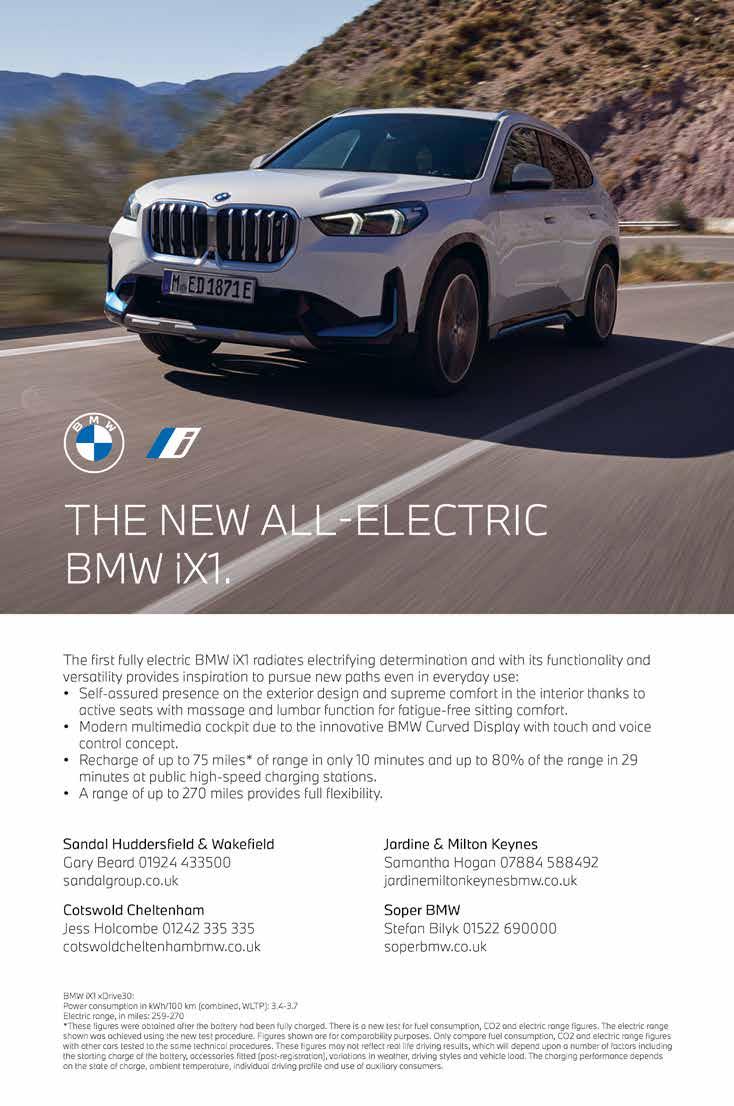
ID.4’s practicality and tax benefits make it your new family favourite
The ID.4 is Volkswagen’s first fully-electric SUV and first global electric vehicle. Like the ID.3, it is based on the brand’s modular, electric drive matrix (MEB) and its entry into the compact SUV market gives VW a competitor in a sector that sees no sign of slowing
The Entry model is the 109kW City Pure 52kWh, costing £34,650, with eight more specs: Life, Style, Life Edition, Style Edition, Family, GTX, Max and GTX Max. The rangetopper is the 220kW 4Motion GTX Max 77kWh which will set you back £58,415.
The smaller 52kWh batteries offer a range of 213-223 miles; larger 77kWh batteries are 288322 miles and the larger 82kWh batteries, available on the Life Edition, Style Edition and GTX, will give you 301-325 miles of range.
Exterior
Unlike the ID.3, which carries a distinctive Volkswagen look about it, the ID.4 is more generic and like a lot of other SUVs, so think Vauxhall Grandland X, Nissan Qashqai and KIA Sportage. The front has narrow, sweeping front lights and a large windscreen. Mirroring the latest Audi EV trend, the rear light cluster spreads right across the back of the car.
Interior
The interior is almost identical to the ID.3. There’s a centrally mounted 10” infotainment touchscreen, a 5.3” dash panel display, a flat bottomed steering wheel and a gear lever on the right end of the centre console that you twist to select from Drive, Reverse or Neutral.
Light grey and gloss black adorn the cabin, with the seats are finished in grey, with a pink/ orange/brown like coloured trim. Build quality is pretty good, although there are some cheaper, harder plastics located lower down.
There’s as much room as you’ll find in a Tiguan. Front seat passengers are spoilt for space, with an armrest each. In the rear there’s room for three adults in comfort with plenty of head and legroom. If there’s only two in the back, an armrest folds down, inside of which there are cupholders. Overall cabin storage is generous but the glove box is tiny.
Luggage capacity with the rear seats up is 543 litres, increasinf to 1,575 litres with them folded. The boot is flat and rectangular, so it’s easy to slide stuff in and out of it. There’s a hidden storage space under the boot floor for the two charging cables.
Equipment and safety
Many of the advanced features seen on the ID.3 are shared with the ID.4, namely ID.Light (the intelligent strip of light below the windscreen that communicates with the driver), the central airbag and Car2X, a system that allows the car to wirelessly exchange
information about local hazards with other vehicles and the traffic infrastructure.
Our test car, the First Edition, came very well equipped with electronic parking brake, a Driver Alert system with fatigue detection, ESC including traction control, 2-Zone ‘Air Care Climatronic’ air con, with keyless entry and starting system. Infotainment and tech isn’t bad, with driver profile selection and personalisation allowing you to set preset your favourite radio stations, phone connectivity and contacts.
Also on offer is a heated, leather-trimmed multi-function steering wheel with aluminium inserts and rake adjustment, front and rear parking sensors, Adaptive Cruise Control, including a Front Assist radar sensor controlled distance monitoring system, with city emergency braking system and Lane Assist.
Charging
Using a standard 7.2kW home charger, it will take 11 hours to fully charge the battery from zero. We recommend Rolec – http://www. rolecserv.com/home-charging. ID.4s are supplied with a 3 32-amp / 7.2kW charging cable and come with a three-year mobility guarantee in case of car breakdown
ID.4 can also be fast charged, either via a 125 kW DC (direct current)or 11 kW AC (alternating current). Using the former means charging to 80% capacity in just 25 minutes.
On the road
The 77kWh battery features a 201bhp electric motor which offers 150kW or 204PS and 310Nm of torque. This will propel the ID.4 quite quickly in a straight line, but on country roads, it’s a little more cumbersome than the ID.3. Thanks to its single-speed automatic transmission and rear wheel drive set-up, it is best enjoyed dawdling in traffic or taking you along a motorway, with both tasks undertaken in supreme quiet and relaxing comfort.
To enhance battery range, you select regenerative brake mode. In Drive, you simply
twist and push the gear lever to select the B function, which gives you access to this. Unlike some EVs, the strength of the regeneration on ID.4 is not that high. The caveat though, is that this also makes the ID.4 better to drive than some of its competitors.
As far as driving modes go, you can select from Eco, the best for saving battery range, limiting you to a top speed of 80mph; Comfort, Sport or Individual.

An 85-mile motorway journey at motorway speeds saw us up 100 miles of range. In town, the B regenerative braking kicks in and you’ll likely see at least a 1:1 ratio of miles travelled to range used. The large 77kWh battery will offer around 250 miles of range without you having to work too hard. Remember that in winter, with several passengers and luggage on board, this will likely fall by around 20%.
Pros
The ID.4’s pros are impossible to ignore for company car drivers. Charging regularly at home and at night on a cheaper tariff will save on your fuel bill and on BIK tax – as little as two per cent. Choose the 82kWh battery and you’re looking at a 300-mile driving range.
Cons
It’s heavy and not as fun to drive as a petrol Tiguan. Some of the fixtures and fittings are disappointing.
CC&V VERDICT
Impressive. A proper family five-seater, with loads of practical space and on-trend tech. BIK benefits are, for now anyway, immense. Perfect for company car driver who needs a large family car and 250-mile range
CC&V RATING: N N N N

36 | February 2023 | Company Car & Van www.companycarandvan.co.uk ON TEST: VW ID.4 www.companycarandvan.co.uk

Qashqai does it again as e-POWER adds more practicality to range

Nissan has added a hybrid model to its Qashqai range, the e-POWER, and compared to other hybrids out there, it’s really rather good.
It has a larger battery – 2.1kWh – than other self-charging hybrids. Charged by a 1.5-litre combustion engine, it delivers good performance, with a 0-62mph time of 7.9 seconds and 105mph top speed. Total output is 187bhp and 300Nm. Compared to the selfcharging hybrids we’ve driven elsewhere, the e-POWER is quiet and smooth, and a much more enjoyable ride than other CVTs, partly due to ‘Linear Tune,’ where the e-POWER matches engine speed to road speed.
Exterior
Despite plenty of upgrades, the Qashqai is unmistakably still a Qashqai. You get vertical air ducts in the front bumper, a floating roof design and LED headlights, but the V-shaped front grille and rear remain, though the lights are slimmer. The main changes are with size. It’s 35mm longer, 20mm in the wheelbase, 25mm taller and 32mm wider, so there’s more interior space all around then in the previous Qashqai.
Our Tekna e-POWER came with rear privacy glass, roof rails, a rear roof spoiler, rear privacy glass and specific e-POWER badging. LED daytime running lights, LED headlights with adaptive beam and LED rear lights also feature.
Interior equipment and quality
The highlight is a much improved infotainment system with a 12.3” touchscreen and connected services such as Apple CarPlay and Android Auto and wireless CarPlay. You also get an electric parking brake, a D-MODE selector (Sport, Normal, Eco, Snow and Off-road are the options) and a push button start, intelligent key, a heated steering wheel, heated front seats, a heated windscreen and a hands free automatic tailgate.
The quality of the fixtures and fittings is excellent, with some nice soft-touch materials and brushed plastics used inside. It’s finished off in black, chrome and grey and overall, it’s a comfortable cabin to be in.
Practicality
From the driver’s seat you get a commanding driving position with excellent visibility. On our Tekna test car, the seats were supportive and well finished. Storage comes in the form of large front door pockets that will take a drink and a good-sized glove box. You also get two cup holders located in-between the front seats and an armrest with storage space underneath.
The increased exterior dimensions provide more head and leg room in the cabin. Thanks to the extra 38mm of width, three adults just about squeeze into the rear. Our car had a panoramic
roof and this definitely reduces rear headroom.
The back seats fold down in a 40/60 split, with the boot now offering a massive 504 litres of storage, and features a number of clever storage ideas, such as removable floor panels and reversible panels.
Safety and security included Active Brake Limited Slip, Hill Start Assist, Vehicle Dynamic

and the ride is never uncomfortable.
EV mode prioritises electric power but it only works at lower speeds in town or very slow traffic. Otherwise the hybrid engine quietly kicks in. We spent our week in Eco mode, primarily to see how good or bad our mpg would be. After 250 miles of mixed motoring in December we averaged 47.9mpg. CO2 is 120g/km. The B regeneration setting which adds a little bit extra in the way of your range.
Control, rear view camera, front and rear parking sensors, driver and passenger airbags, plus curtain and front side, far-side airbags.
On the road
We were testing the e-Power Tekna Acenta 190 auto which came with Nissan’s ProPilot+ system. On the motorway it offers Intelligent Cruise Control, Lane Departure Warning and Prevention and Blind Spot Warning. These are brilliant and driver friendly.
In town, you can take advantage of Intelligent Forward Collision Warning and Forward Brake with Pedestrian, Cyclist and Junction assist. Lane Departure is a little annoying and the Forward Collision a little too keen to take over. Otherwise, these safety features are an excellent addition to the Qashqai range.
Ride comfort is very good. On winding roads the suspension works well and the ride is supple, especially compared to the Tiguan, for example. Nissan has clearly prioritised ride comfort over performance. The steering is light, which is useful in town, but not so good on the open road, where there’s a tendency for it to lack control in corners. The suspension is soft
The e-POWER has been designed for those not yet ready to switch to a full EV, though when driving it feels very much like an EV with a hum accompanying the ride. And like many EVs, you also have an i-Pedal feature. This offers energy regeneration when you take your foot off the accelerator. It’s not too intrusive and certainly doesn’t offer EV one-pedal driving, but adds a few extra miles to your fuel economy.
Pros
Excellent mpg, very well built, packed full of tech and safety and comfortable to be in. Large boot with clever and practical removable shelving. Low CO2 means lowish BIK.
Cons
Expensive, with our Tekna costing from £38,140. For keen drivers, it doesn’t offer any driving excitement.
CC&V VERDICT
It’s missing some of the Ariya’s exciting design DNA, but it’s a practical five-door SUV that’s hard to beat. Large boot, a much improved interior, on trend tech and excellent safety all wrapped up in a good-looking package.
The e-POWER engine is well worth a look.
CC&V RATING: N N N N
38 | February 2023 | Company Car & Van www.companycarandvan.co.uk ON TEST: NISSAN QASHQAI www.companycarandvan.co.uk
On the road the drive is good, the suspension works well and the ride is supple... Nissan has clearly prioritised comfort
‘‘ ‘‘
Chorley Group helping you make the switch
Chorley Group is an award-winning, family-run business providing the North West with multi-franchise options on new commercial or personal vehicles. With brands including Nissan, MG, Kia, Hyundai, Vauxhall, Citroen and Isuzu, the business is growing year-on-year and providing customers with more choice than ever for new vehicles.

But a continually growing area of the business is EV, Plug-In Hybrid (PHEV), and Hybrid fleet vehicle sales, with the Society of Motor Manufacturers and Traders (SMMT) confirming that in December 2022, batteryelectric models accounted for one-third of all UK car sales. The Chorley Group is staying one step ahead of this trend thanks to its Fleet Manager, John Link, and Innovation Development Manager, Miles Roberts.
John, along with Assistant Fleet Manager, Robson Broomhead, provides businesses with a range of EV, PHEV and Hybrids from their multiple brands – with the new Nissan Qashqai with e-POWER and MG4 EV now available to test drive for potential customers.
The new Nissan Qashqai with e-POWER incorporates the best of combustion and electric to provide customers with EV driving without range anxiety and the full cost of an electric vehicle. e-POWER works by driving the wheels with an electric motor, similar to the one

found in the Nissan ARIYA, and helps provide the instant responsiveness and torque of an electric vehicle, while being backed up by an efficient petrol engine that charges the battery – resulting in lower emissions and running costs. This helps customers who are on the fence about converting to EV get a chance to experience what driving an electric vehicle could be like.
The MG4, on the other hand, is a fullyelectric, multi-award-winning hatchback that comes in two variants: a 51kWh battery SE that provides up to 218-miles of range, and a larger 64kWh battery for the SE & Trophy Long Range models, increasing the range up to 281-miles.
Considering it is one of the most inexpensive EVs, the MG4 comes with standard equipment that you would normally only find on some other
higher-end brands. The technology includes a 10.25” floating infotainment display, Apple CarPlay & Android Auto, iSMART mobile phone app integration, 7” driver information display, and MG’s advanced driver assistance system, MG Pilot.
On the Trophy model, customers will benefit from satellite navigation, wireless phone charging, 360° parking camera, and heated seats/steering wheel for an even more premium experience with the MG4.
Chorley Group knows that making the change from combustion driving to EV can be daunting, especially if customers are kitting out their business with a brand-new fleet of vehicles. This is where our Innovation Development Manager, Miles Roberts, comes in. Miles works closely with John and helps businesses and personal customers by informing and explaining the benefits of electric/ hybrid driving and how it can have an impact on their business both financially and economically.
This works hand-in-hand with the GoEV YouTube channel where Miles reviews the latest vehicles and technologies from Nissan, Hyundai, Kia, Citroen, Vauxhall and MG. The channel has been a great source of custom for the Group, with businesses and personal customers making the switch to electric motoring thanks to its informative videos.
COMPANY NEWS www.companycarandvan.co.uk www.companycarandvan.co.uk Company Car & Van | February 2023 | 39
Townstar picks up
the
The successor to Nissan’s hugely successful e-NV200, the Townstar, is primed to futureproof business operations and accelerate the transition towards electrification.
Key to its appeal, however, will be the fact that it offers two highly advanced powertrain solutions – one petrol and one fully electric, in combination with the latest driving technologies.
For customers looking towards zero emission motoring, prices will start from £29,945* for a short-wheelbase Townstar equipped with a 45kWh battery, with a range of up to 183 miles WLTP combined or up to 269 miles in city cycle.
Alternatively, a refined 1.3-litre TCe petrol unit is also available and is fully compliant with the latest Euro 6d-Full emissions regulations, delivering 130HP of power and 240Nm of torque, offering power and efficiency in equal measure. Petrol versions of Townstar start from £19,475.
Townstar brings a suite of 20+ technologies to the compact van segment and will feature a broad range of safety technologies and advanced driver assistance features such as Intelligent Emergency Braking, Hands-Free Parking, Intelligent Cruise Control and Around View Monitor (AVM), exclusive to Nissan, putting it at the forefront of its category.
The exciting line-up comprises four generously-specified trim levels: Visia – well equipped and ready to work; Acenta – featuring enhanced facilities to accommodate most professional needs; Tekna, incorporating additional driver convenience and exterior styling; and Tekna+, combining the very latest
technology with enhanced driver assistance.
When it comes to carrying capabilities, Townstar provides a generous payload of up to 600kg (SWB) or 800kg (LWB). In addition, the maximum braked towing capacity is 1,500kg.
Allan Newman, LCV product manager at Nissan GB, said: “We’re delighted to be providing more information about all-new Townstar as its arrival in the UK approaches. Offering two efficient powertrain solutions, practical design and unique Nissan

Electric versions
Electric versions of the all-new Townstar are priced from £29,945 and will come with an 11kW (Visia grade) or 22kW AC (Acenta grade on) on-board charging system which will be class-leading in its segment. As with its e-NV200 predecessor, there will also be a DC rapid charging connector standard from Acenta grade, which can recharge the battery from 0% to 80% in a little over 40 minutes.


Prices for all-electric short-wheelbase examples range upwards to £34,845 for a Tekna+ model. Long-wheelbase all-electric Townstar varies in price from £31,245 (Visia) to £35,845 (Tekna+).
Petrol versions:
On petrol versions, the aforementioned £19,475 price tag applies to a SWB Visia trim-level vehicle, powered by Nissan’s 1.3-litre TCe petrol engine and with a six-speed manual transmission.
The most expensive short-wheelbase petrol-powered Townstar, in top-of-the-range Tekna+ specification, comes in at just £23,125.
technologies, it is comprehensively equipped to meet customers’ ever-changing needs.
“With tougher emissions standards, urban access restrictions, and ever-increasing demand for last-mile delivery, businesses large and small need to find effective and sustainable solutions to remain competitive and optimise their operations.
“We’re confident Townstar will meet their every need.”
Turning to long-wheelbase petrol options, prices range from £20,775 (Visia) to £24,425 (Tekna+).
Furthermore, this is backed by a panEuropean five-year or 100,000-mile warranty, in addition to the eight-year or 100,000 miles battery warranty for the EV version. This includes bumper-to-bumper protection, genuine parts and accessories and roadside assistance – providing comprehensive cover for extra peace of mind.
40 | February 2023 | Company Car & Van www.companycarandvan.co.uk CV NEWS: NISSAN TOWNSTAR www.companycarandvan.co.uk
e-NV200’s mantle to deliver
goods For customers looking towards zero emission motoring, the short-wheelbase Townstar has a 45kWh battery with a range of up to 183 miles WLTP or 269 miles in city cycle ‘‘ ‘‘
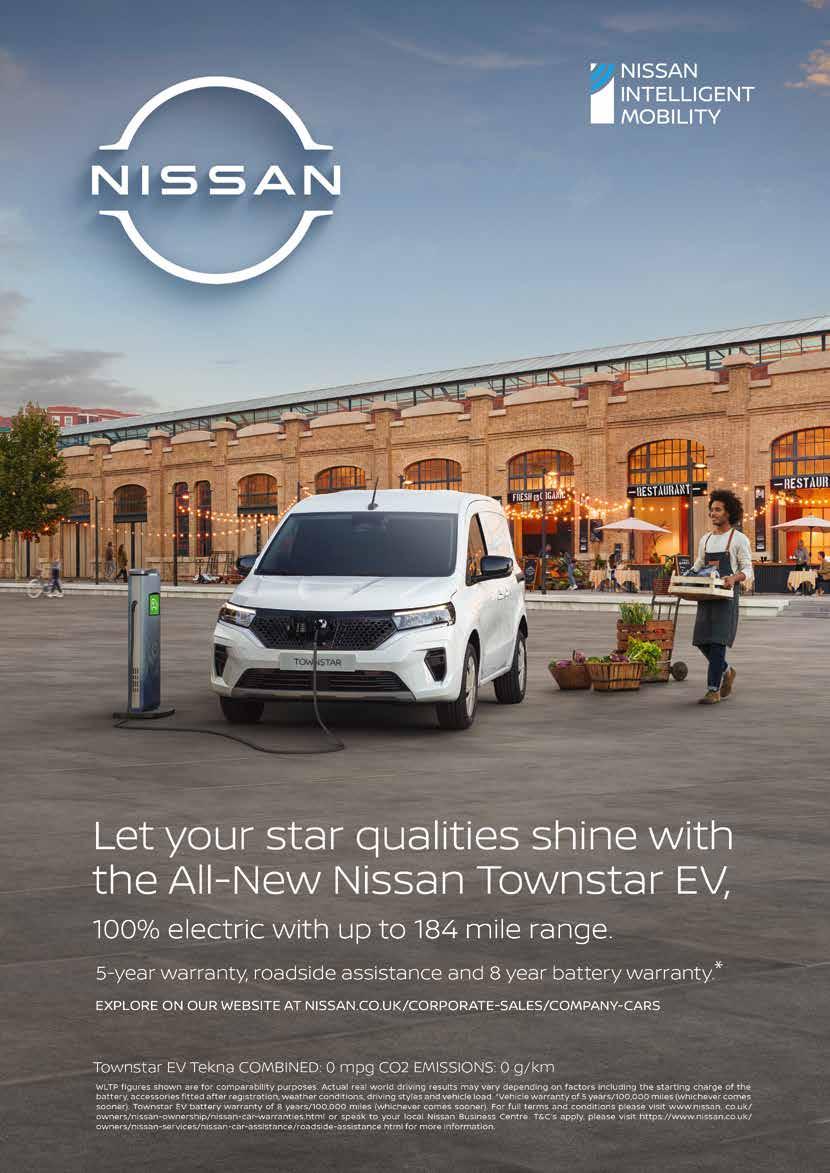
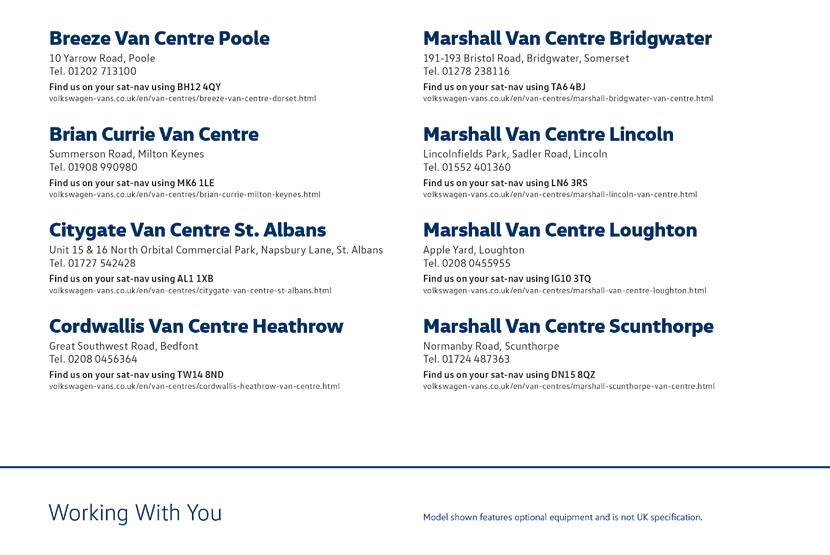

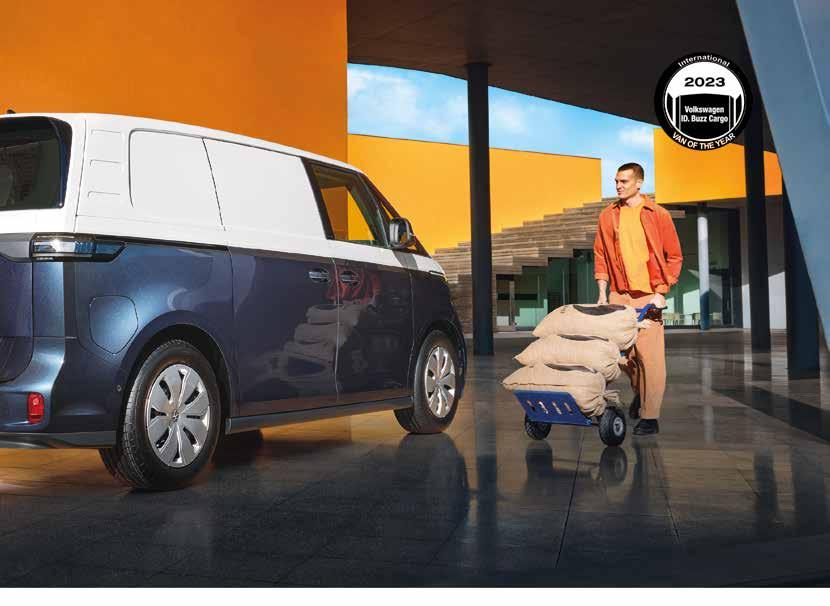

The ID.Buzz Cargo is the first all-electric van from Volkswagen Commercial Vehicles. It’s built on the MEB Platform that also features on the company’s ID. car range, but what makes it really stand out is that it has been designed with more than a nod to the classic Type 1 VW panel van from 1949, meaning it has a truly retro look. There are two models to choose from, the Commerce and the Commerce Plus, with prices starting at £46,621 including VAT
Exterior
In a world of bland vans the Buzz Cargo is refreshingly different. At the front it has high LED headlights, with a slim lateral bar joining these with the large VW logo in the middle. Beneath this sits a honeycomb grille. The sides are smooth and flat, while the rear double doors also feature a mid-height light bar and narrow corner LED rear lights.
Interior
As standard it has three seats in the cab: driver’s seat plus double bench seat, though you can option a single seat for the front passenger. There’s a fixed bulkhead and this can be personalised with a window or a hatch.
The dashboard layout, fixtures and fittings will be familiar to existing VW customers. All are well made, look good and feel durable. The main colour options are dark grey, black and chrome. The centrally located 10” infotainment touchscreen sits neatly in the centre on what is a very uncluttered dashboard.
The cockpit in front of the driver has a 5.3” ID. Cockpit display, and steering wheel controls can be used to access the Adaptive Cruise Control and other safety features.
Practicality
The ID.Buzz Cargo is fitted with hard-wearing basket cloth seat upholstery and a heated driver’s seat. You also get a cabin width storage area on top of the dash, a decent glove box, a cubby hole on the dash and space above the glove box and double door storage.
The rear load space features LED lighting, four floor load lashing rings and lashing rails on the side walls. Cargo load space is 3.9 m3 with room for two Euro pallets. The load space measures 1,217 mm wide x 2,208mm long. GVW is 3,000 kg. Maximum payload is 607 kg, with a 1,000 kg braked towing capacity. Cargo also comes with twin sliding side doors and a wide opening tailgate. There’s a space under the right-hand side load floor for your charging cable and handily, the charging sockets are located on the rear right side of the van.
Battery, range and charging
The $64,000 question with all EVs is how far will it go and how long does it take to charge? With a 77kWh battery the Cargo has range of 256 miles. On an 11 kW AC charger, the battery can go from 0 to 100 % in seven hours 30 minutes. On a 7kW home charging wall box, such as our own Rolec, (https://www.rolecserv. com/ev-charging) a full charge will take around
Creating a buzz
11 hours. Buzz Cargo can be charged at DC fast-charging stations at up to 170 kW. In this case, the battery is charged up from 5 to 80 per cent in around 30 minutes.
Performance
The electric motor is integrated into the driven rear axle and develops a power output of 204 PS. 310 Nm of torque delivers enough power to reach 62 mph in 10.2 seconds. The top speed is electronically limited to 90 mph.
Four driving modes are offered: Eco, Comfort, Sport and Individual. There’s also a B regeneration function, so once you are in Drive D, twist once more to engage this. It works really well, slowing you down when you take your foot off the accelerator, extending range.
Behind the wheel
The Buzz Cargo is without a doubt the easiest medium-sized van you can drive. It’s equipped with all of the same functions, physical switches and buttons as the ID car range, making it a large car driving experience.
The driver’s seat is supportive and comfortable, the steering wheel multi-adjustable and a good driving position is easy to find. Reaching and selecting the gears is easier than in the ID cars and the clutter-free dash is a design dream.
Riding on standard 18” steel wheels, the ride is excellent, with the battery weight evenly spread out to encourage the Cargo to grip the road, especially at corners.
Head onto the motorway and everything is serene. Select cruise control to 62mph and the Buzz Cargo will eat up the miles in almost silence and not drain your battery too quickly either. Driver and front passengers get plenty of head and legroom and all of the controls,
including the dash-top drinks holder, are easily reached from the driver’s seat.
Real world driving range
We only travelled 75 miles in the Buzz Cargo, mostly on B roads, some A roads and a stretch of the M40. Our Cargo range showed 231 miles when we climbed aboard and after utilising the B regeneration function at a steady 62mph, the range left was 172 miles, so pretty impressive. We’d commit to an average range of 200 miles, 250 in warmer weather and 160 in colder weather.
Pros
Quite easily the best looking van you can buy. Brilliantly bolted together with on-trend tech and connectivity. It’s also relaxing and easy to drive and gives a comfortable ride.
Cons
It’s an EV so the range is less than on a diesel. The battery and weight eat into the rear load space, with only a 607kg or 592kg (Commerce Plus ) payload. In comparison, the Vauxhall Vivaro Electric has a 1,000kg payload on it’s 75kWh battery offering.
CC&V VERDICT
It will divide opinion: Very good electric range but compromised by its carrying capacity which is lower than the Citroen e-Berlingo or Fiat e-Doblo. That misses the point: the ID.Buzz Cargo is the first electric van that puts style over substance. Refreshingly different
CC&V RATING: N N N N N

44 | February 2023 | Company Car & Van www.companycarandvan.co.uk ON TEST: VW ID. BUZZ CARGO www.companycarandvan.co.uk
The retro-look ID. Buzz Cargo is definitely causing quite a stir, says Andrew Walker
Range boost makes the eVito a real option for delivery fleets
Mercedes has massively improved the battery range of its eVito, making it far more attractive prospect. Andrew Walker got to grips with one recently and here’s how we got on.
The upgraded eVito looks and feels the same as a diesel model, except that it’s powered by an 114bhp 85kW electric motor offering 300Nm of torque. The improved eVito now features a 66kWh battery with a WLTP range of 162 miles; that’s up from the 93 miles of its predecessor.
AC charging to 11kW and DC to 80kW are both standard on eVito. As ever, plug-in at home or at work for cheaper rates – we use Rolec chargers, https://www.rolecserv.com/ ev-charging
Model range and sizes
We were testing the PREMIUM eVito. It costs from £46,900, though a cheaper PROGESSIVE is also available. eVito comes in two lengths, L2 or L3, with the smaller model offering 6.0 m3 cargo volume, the larger one 6.6 m3
Specs and safety
eVito PROGRESSIVE offers colour-coded bumpers, full wheel covers, front fog lights, Headlight Assist, a 75mph speed limiter, Audio 30, lumbar support and electrically foldable mirrors. PREMIUM adds Hyacinth red metallic paint, a spare wheel with jack and a leather steering wheel, PARKTRONIC, reversing camera, hate insulting glass, TEMPMATIC semi auto air-con and cruise control.
Exterior and interior
From the outside it looks like a standard Vito and you’d be hard-pressed to know it’s electric unless you spot the discreet eVito and eLECTRIC badging.
Inside you’ll find the updated Vito interior, which includes two USBs and a heated front driver seat. There’s a three-seat configuration up front, as well as some top-of-the-dash storage, a decent glove box and two handy deep door pockets, but there’s nowhere to fit a large bottle or drinks container.
The ignition is on the left of the usual steering column, while the gear lever is mounted on the right, meaning the headlight and wipers are both on the right stalk. Cue changing into neutral a lot when it rains!
Power steering is standard and the wheel is both rake and reach adjustable. The driver’s seat also offers a myriad of adjustment, so getting comfortable was not a problem.
The hand brake is located on the floor as it is in Mercedes cars. You push a ‘fourth’ pedal with your left foot to engage the brake and then pull a dash-mounted lever to release. I found it
straightforward to use, although some may not like it as it doesn’t help you with hill starts.
In the centre of the dash and higher up than in some vans are the Audio 30 infotainment
hand slide-opening side doors and twin rear doors that open 180 degrees.
Driving
Of more interest I’m sure, is how the eVito drives and how far one can travel in it. It’s easy to drive and very relaxing on the motorway. The gear lever offers Neutral, Reverse or Drive options and even with the battery weight underneath the floor, the eVito handles pretty well for its weight.
As with most electric cars, the eVito offers several levels of regenerative braking, which can be adjusted using the paddles on either side of the steering wheel.
system and heating controls. The infotainment screen is slightly awkward to reach for the driver, as are the USB inputs on the left of the dash. For a left-hand driven Vito this location would make perfect sense, but not so for UK right-hand-drive versions.
The front windows are electric and keeping the cabin quiet is a full width bulkhead. The quality is top-notch but it’s not as practical a cab as some competitors.

Loadspace
The rear load space is easily accessed as the L2 Vito we drove comes with left and right
This enables you to utilise D-, the strongest regenerative level, which is also the most noticeable. You can then decrease the strength of regeneration by pulling on the right hand paddle, moving through the options of D, then D+ and as we found for motorway driving the very useful D++.
There are three drive modes; E+, E or C. E+ offers the most efficient driving style; E is the middle option and the one we preferred, or you can select C, which is the least efficient, but the most fun.
The eVito was delivered with a full charge, and the gauge said we had a 157-mile range. We covered 30 miles at 70mph driving to Chester via the M56, using drive mode E. On arrival we charged up while we shopped.
Continued
ON TEST: MERCEDES BENZ E-VITO www.companycarandvan.co.uk www.companycarandvan.co.uk Company Car & Van | February 2023 | 45
on page 46
It’s easy to drive and relaxing on the motorway. The gear lever offers Neutral, Reverse or Drive options and even with the battery weight under the floor, handles pretty well for its weight ‘‘
‘‘
Continued from page 45
Our journey had decreased the range from 157 miles to 118 and after an hour charging was up to 126 miles for the return leg. Thirty miles later and back home, the range now showed 98 miles.
We repeated the journey the following day and concluded that if driven unladen with just a driver, at mostly motorway speeds, the eVito has a 140-mile range. At lower speeds of up to 50mph the range increased to 157 miles, as you can really take advantage of the regenerative braking to top the battery up.
That means eVito can now match, or even surpass, Stellantis vans’ claimed WLTP battery range of 143 miles.
Pros
That much improved battery range now gives the eVito a competitive range. The cabin is hewn from granite, top quality and very comfortable. The addition of proper air-con is also an improvement. The overall build quality puts the competition to shame.
Cons
The infotainment system isn’t as good as you’ll find on some other vans. Similarly, neither is the payload.
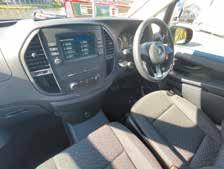
Conclusion
The improved range makes longer journeys a lot less stressful and you can trust the range. It’s comfortable, quiet to drive and offers Apple CarPlay or Android Auto, something we really can’t live without.
You may consider a 150-160 mile range nowhere near enough, but we reckon that plenty of businesses don’t need a complete fleet of long-distance vans. Ultimately, we think it will come down to the buyers’ confidence in the eVito’s range, their daily mileage, plus their access to charging points.
If your business has charging stations, or you have one at home, there really is nothing to fear from an electric Vito.
CC&V VERDICT
The increase in range is a real game changer and sweeps away the biggest concern we had about owning and running one
CC&V RATING: N N N N N
Head-on Electrical charges ahead with zero-emission vans
Hull-based Head-on Electrical has taken a positive stride towards switching its entire van fleet to clean, green battery power – courtesy of Mercedes-Benz specialist Northside Truck & Van Ltd.

The successful contractor runs a fleet of 12 vans, each racked to carry tools, cabling and other components used by its electricians to take on assignments for a wide range of commercial and domestic clients across the city and beyond – including the installation of electric vehicle recharging points.
Head-on Electrical was established in 2009 by brothers Tony and James Fethon and now employs a team of 35 colleagues, who work across Hull and the East of Yorkshire. The company boasts accreditation from the National Inspection Council for Electrical Installation Contracting (NICEIC) and offers a range of services, from issuing Electrical Safety Certificates to partial and full rewires for domestic and commercial properties of any size, and providing electric vehicle charging points as an approved installer for the EV Chargers UK brand. Head-on is proud to be ‘big enough to cope, small enough to care’, and places top-quality customer service at the heart of its business.
Tony Fethon said: “Given that an increasing amount of our work is in the provision of charging infrastructure to help customers switch over to electric vehicles, it makes obvious sense for us to be running batterypowered vans on our own fleet.

“This Mercedes-Benz eVito is the first of many, and is already proving to be a great
mobile advertisement for our company as well as a highly effective and efficient performer.”
Tony added: “Moving to electric transportation will be a major step forward in our strategic goal to reduce the impact of our activities on the local environment as much as possible and make the company as sustainable as it can be – we see this as part of our responsibility to care for the community in which we all live and work.”
The keys to the first eVito were handed to Senior Electrician Paul Sinclair. “I’d never driven an electric vehicle before but making the transition was no problem at all,” he observed. “Our local retailer gave me a thorough introduction to all the controls and functions, and it felt like second nature in no time at all. Now I love driving the eVito – it’s much smoother and quieter than a diesel van, and with full torque available from a standstill the performance feels effortless.”
The L2 long-bodied eVito was supplied in showroom condition, was actually a used vehicle – albeit with just 500 miles on the clock.
“The availability of a used model made this green option even more accessible,” recalled Tony Fethon. “Like any operator we’re keen to keep our total cost of vehicle operation as low as possible. The two-year ServiceCare package means running costs will be easily predictable, and our own charging point supported by a solar panel helps to minimise topping-up costs – all of which means the eVito makes financial as well as environmental sense. Now we’re looking forward to adding more, as soon as possible.”
46 | February 2023 | Company Car & Van www.companycarandvan.co.uk MERCEDES BENZ eVITO / NORTHSIDE TRUCK & VAN www.companycarandvan.co.uk
Green for go: Head-on Electrical Director Tony Fethon sees the benefits of switching to the MercedesBenz eVito

Maxus is backing the pick-up sector – and its T90 will get the job done
Even as some of its rivals have pulled out of the pick-up sector, Maxus has plunged right in with a bold electric option, the T90. Andrew Walker checks it out
We’re lucky enough to be based just 30 minutes away from the Maxus UK head office in Liverpool, which means that when given a chance to pop over and take a look around the all-new Maxus T90 electric pick-up, it was too good a chance to miss.
The T90 was first seen at the 2022 CV Show, where the promise was of a right-hand drive version in late 2022.
It may be an electric pick up, meaning there’s a heavy battery fitted underneath the cab and load floor, but this doesn’t prevent it from being a highly practical vehicle. It offers a one-tonne payload and can tow up to 1,500 kg. See the panel top right for dimensions.
Electric range and battery
Maxus claims that the T90 offers a 220-mile range, courtesy of its 88.5kWh battery which produces 201bhp.
It has a rear-wheel drive set up, which means that the motor and battery may affect its
off-road capabilities.
Exterior
The front features a massive chrome grille with the Maxus logo at the top. The side LED daytime running light intakes bear a passing resemblance to a Mitsubishi L200, while the rear load bed area is very similar to that found on an Isuzu D-Max. The tailgate is heavy and closes with a nice clunk.
There’s a large Maxus logo across the rear, a high mounted stop light and a step in the bumper to allow for easier access. The sides feature black steps and a chrome low door protector.
Front and rear bumpers are body coloured.
Inside
Quality wise, it’s pretty good, with the fixtures and fittings in keeping with those on the Isuzu D-Max, Toyota Hilux and Mitsubishi L200. However, if you’re expecting the more upmarket interiors found on a Ford Ranger Wildtrak or Volkswagen Amarok, you’ll be disappointed. It’s built to do a job, not for your lifestyle.

There’s no gear lever. Instead, you’re presented with a cylindrical dial with a simple Reverse, Neutral or Drive option. Alongside this sit Power, Eco, Downhill and ASR buttons.
The four door pockets are sizeable with twin drinks holders located between the front seats, a centre armrest with storage underneath, although the glove box is small.
You get a neat 10.5” infotainment touch screen, an AM/FM radio and you can connect your Smartphone via Apple CarPlay, using one of the two front USBs that sit underneath. Separate climate controls are located underneath this with manual air-con fitted. You get a 12v socket up front, plus one in the rear as well as a 220v power outlet.
The front seats are electrically adjustable, while the seats are finished in artificial leather.
Rear space is really good and three adults should fit comfortably.
Equipment and safety
There’s plenty of safety kit in the form of ESP and EBA, driver and front passenger airbags and side airbags, with front to rear curtain airbags standard as well. You also get a reversing camera, rear parking sensors and rain sensing wipers.
Continued
48 | February 2023 | Company Car & Van www.companycarandvan.co.uk ON TEST: MAXUS T90 www.companycarandvan.co.uk
on page 50
Dimensions T90 dimensions mirror a standard diesel pick-up. Length 5365mm Width 1900mm Height 1809mm Wheelbase 3155mm Cargo bed 1510mm (l) x 1485mm
x
(w)
530mm (h)

Extras
Your T90 can be spruced up and personalised by adding one or more of a number of additional items of equipment and style touches: stainless steel sports bar, a roll lock cover, all terrain tyres, a mountain top/ roller top, a tow bar with electrics, a front bumper winch pack or a hard top box with rear tailgate wash wipe.
Charging
The key feature of any electric vehicle is range, and here the T90 scores highly, thanks to its large battery. The caveat is that it will take longer to charge: approximately 12 hours from 0-100% on a 7kWh home charger.
That will take a little bit of logistics and planning.
Better news is that if you utilise its DC capabilities, a 20-80% charge will take only 45 minutes. The T90 is supplied with a five-metre Type 2 charging cable with the external charging cap located on the rear left of the cab. As usual, our advice is to get a home charger, plug-in overnight when electricity is cheaper and get some chargers at your workplace, too. It’s a sound investment.
Driving
We only spent 30 minutes driving the T90 on
urban roads but what we were able to ascertain from this was the following.
Apart from the electric whine when you first accelerate, the T90 is quiet, eerily so when compared to a standard diesel pick-up. Up front the ride is quite firm. In the rear we’d guess that, unlike a diesel pick-up, where the weight is all located at the front, the T90, with a heavy battery underneath the cabin floor, won’t be as bouncy for rear passengers when unladen. It will be interesting to see how it performs off-road.

All of the dials and switches are easy to reach and to understand. The touchscreen is quite basic but the functions work well, and Apple CarPlay connected seamlessly. AM and FM radio are standard, but if you want DAB you’ll need to connect to your favourite station via your Smartphone Apps. There’s a SatNav, too.
Pros
It has the virtue of being the first electric pick-up you can buy in the UK. Even better, it

Continued from page 48
50 | February 2023 | Company Car & Van www.companycarandvan.co.uk ON TEST: MAXUS T90
comes with a decent payload and load bed area. Electric range is impressive and it is well equipped.
Cons
This was a fleeting glimpse of the T90’s capabilities and we’ve yet to take it off-road where there is a chance that the low hanging motor-battery combo may affect ground clearance.
One other point: at £49,950 + VAT, it’s not cheap.


Conclusion
In the UK, Maxus has won the race to get an electric pick-up to market. Utilising parent company SAIC’s battery know-how, Maxus has gone from selling 100 vans in 2017 to over 12,000 in 2021, with the electric eDeliver 3 and eDeliver 9 leading the charge. As I write this, Ford has an E-Transit out, but there are no signs of an electric pick-up from them, or from Toyota, Isuzu or Volkswagen. This gives Maxus a massive opportunity, with plenty of forward orders already confirmed.

‘‘
‘‘
Our only reservation is that it remains to be seen how the T90 performs off-road and price-wise, it’s expensive to buy outright, so leasing will be the best way to get into one. That being said, it’s definitely one for the future.
CC&V VERDICT
Being the first to achieve anything is always something to boast about, and Maxus should be congratulated on that feat. If pick-ups are your go-to vehicle for the workplace, the T90 gives you an electric option you can work with
CC&V RATING: N N N N N
www.companycarandvan.co.uk www.companycarandvan.co.uk Company Car & Van | February 2023 | 51
There’s plenty of safety kit, plus a reversing camera, rear parking sensors and rain-sensing wipers... plus it’s a highly practical vehicle
Harris Maxus eyes growth as it moves HQ to new Liverpool site
Having outgrown its UK headquarters in Warrington, Harris MAXUS has moved to a new premises in Liverpool as the company continues to grow its presence in the UK. The new Harris HQ is quadruple the size of the previous Harris Headquarters, which was only opened in 2021.
Harris MAXUS, which is one of the UK and Ireland’s leading automotive companies, officially opened the new HQ today at Gillmoss Industrial Estate with a ceremony that was presided over by Liverpool’s Lord Mayor, Councillor Roy Gladden, with Mark Barrett, General Manager, Harris MAXUS and Denise Harris, CEO of The Harris Group, in attendance.
Parent company, Harris Group, is recognised as one of the UK and Ireland’s foremost distributors of commercial vehicles, including its flagship electric vehicle brand, MAXUS. The company holds the distribution rights for MAXUS vehicles across all right-hand drive countries in Europe and has seen significant growth in demand for its EV range of light commercial vans.
Owned by SAIC Motor Corp. Harris MAXUS is currently forecasting growth of over 200% in the UK in 2023, with sales across the UK and Ireland for 2022 of around 6,000 units.
The new 52,000 sq ft premises will house 30 staff including Harris MAXUS’ technical, distribution and sales teams in addition to a parts depot and warehouse. A training centre for engineers taking part in MAXUS’ technical training academy will also be on site.
Mark Barrett, General Manager of Harris MAXUS said: “At the start of 2021, Harris opened its first UK headquarters in Birchwood Park, Warrington. In less than two years, we have outgrown what was already a sizeable building, moving to a new state-of-the-art campus in Liverpool.

“The success of Harris MAXUS in the UK has exceeded all expectations. We have seen MAXUS vehicle registrations grow by 52% versus 2021, with 38% of our overall sales in 2022 attributable to our zero-emission range of vehicles.
“At Harris MAXUS, we are fully focused on the future, not just in terms of expansion in the UK, but also in terms of the vehicles we put on UK roads. This year, we launched the world’s
first all-electric, MPV - the MIFA 9. We also launched the UK’s first fully electric pickup truck, the T90EV.
“Over the next two years, we have plans to introduce four new zero-emission platform vehicles to the market.
“Our move to Liverpool is central to our future plans and we are committed to growing our presence in the UK, creating more employment, developing our dealership network and making a valuable economic contribution both locally and nationally.”
Speaking at the opening ceremony, Liverpool’s Lord Mayor, Councillor Roy Gladden said: “Businesses are very much the bedrock of our city; not only do they contribute to the local economy by bringing growth and employment to the area, but they also bring innovation and fresh thinking.
“The Harris Group exemplifies all of these things, creating skilled jobs and driving the transition to greener motoring through its range of zero emission vehicles. It is with great
pleasure that I welcome the team from Harris MAXUS to Liverpool and wish them every success as the business continues to grow.”
As the sole distributor for the MAXUS diesel and electric range of vehicles in right-hand drive markets in Europe, Harris MAXUS delivers a significant number of vehicles every week to an extensive network of more than 50 dealers across the UK.
Founded in 1961 by Robert ‘Pino’ Harris, the late husband of CEO, Denise Harris, The Harris Group is a leading importer and distributor of commercial vehicles with a firm focus on technological innovation and the next generation of clean vehicles driving more sustainable motoring.
Denise Harris joined Cllr. Roy Gladden in unveiling a plaque to mark today’s event, dedicated to the memory and great legacy of Pino Harris.
Harris MAXUS is now located at 1 Carraway Road, Gillmoss Industrial Estate, Liverpool, L11 OEE. More at www.saicmaxus.co.uk

Company HQ quadruples in size as MAXUS gears up for vehicle launches and continued growth
52 | February 2023 | Company Car & Van www.companycarandvan.co.uk COMPANY NEWS: MAXUS www.companycarandvan.co.uk
Liverpool’s Lord Mayor, Councillor Roy Gladden, greets Mark Barrett, General Manager, Harris MAXUS and Denise Harris, CEO of The Harris Group
Denise Harris joins Cllr. Roy Gladden in unveiling a plaque to the memory and great legacy of Pino Harris
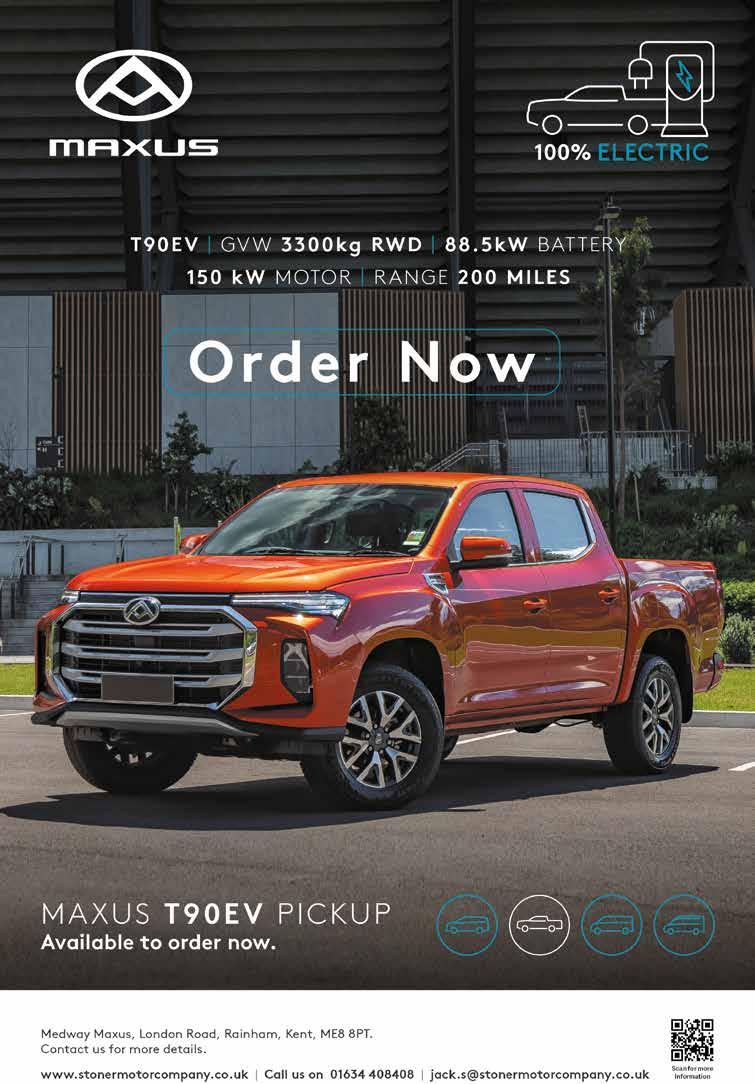
Ranger’s ready for anything
The all-new, next-level Ford Ranger Raptor has arrived, carving the way for the exciting new generation of Europe’s market-leading pickup. The second-generation Ranger Raptor raises the off-road performance bar and embodies the smarter, tougher, more capable character present in every new-generation Ranger.
Developed by Ford Performance, the all-new Ranger Raptor is the ultimate derivative of the latest Ford Ranger. With smarter technology controlling tougher, next-generation hardware, Ranger Raptor blends raw power with mechanical and technical precision to create the most advanced Ranger ever.
“We’ve really focused on delivering a genuine performance truck with the all-new Ranger Raptor,” said Dave Burn, Ford Performance chief programme engineer for Ranger Raptor. “It’s significantly faster, looks incredible, is packed with new features, and it’s the toughest Ranger we’ve ever made.”
More power to play
The biggest news for performance fans is the introduction of an all-new twin-turbo 3.0-litre EcoBoost V6 petrol engine tuned to produce 292PS and 491Nm of torque.
The twin-turbo 3.0-litre EcoBoost V6 engine boasts a compacted graphite-iron cylinder block, which is around 75 per cent stronger and up to 75 per cent stiffer than the iron used in traditional castings.
“The 3.0-litre engine brings a different dynamic to the Ranger Raptor that will satisfy even the most hardcore performance enthusiast,” Burn said. “The acceleration and raw performance of the new powertrain leave you grinning from ear-to-ear.”
Hardware for heavy hitters
The all-new Ranger Raptor has a unique chassis frame and suspension compared to other Ranger variants. A series of Raptorspecific mounts and reinforcements for
elements including the C-pillar, load box and spare wheel, as well as unique frames for the jounce bumper, shock tower and rear shock bracket all combine to ensure the ultra-tough pickup can handle punishing conditions.
A high-performance off-roader like the Ranger Raptor needs the running gear to match, so Ford engineers completely redesigned the suspension. All-new tough yet lightweight aluminium upper and lower control arms, long-travel front and rear suspension and a refined Watt’s link rear end have been designed to deliver more control across rough
Tough and athletic looks
Matching the enhanced capability of Ranger Raptor is an all-new look that builds on the nextgeneration Ranger’s bold, strong style. Flared wheel arches and C-clamp headlight designs emphasise the pickup’s width, while bold F-O-R-D lettering on the grille and the tough separate bumper add more visual muscle.
Customers can choose from seven exterior colours, including striking, Raptor-unique Code Orange or Conquer Grey that reaffirm the pickup’s exclusivity and performance. For even more visual punch, Ford offers Raptor splash decal graphics that add race-inspired character.
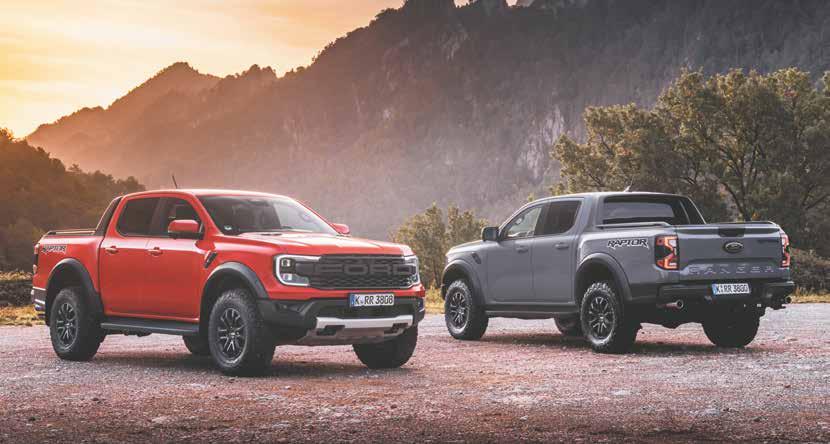
The matrix LED headlights with LED daytime running lights push Ranger Raptor’s lighting performance to new levels, featuring predictive curve lights, glare-free high beam and auto dynamic levelling to deliver better visibility for Ranger Raptor drivers and other road users.
terrain at high speed.
Ranger Raptor’s ability to tackle rough terrain is further enhanced with some serious underbody protection. The front bash plate is almost double the size of the standard Ranger’s unit and is made from 2.3 mm-thick highstrength steel. This plate, combined with the engine undershield and transfer case shield, is designed to protect key components.
All-terrain control
For the first time, Ranger Raptor gets an advanced full-time four-wheel drive system with an all-new electronically-controlled on-demand two-speed transfer case.
The Raptor offers both front and rear locking differentials, with the new front differential providing a valuable additional feature for off-road use.
The flared fenders cover muscular 17-inch alloy wheels wrapped in Raptor-exclusive performance all-terrain tyres. Functional vents, aero features and tough, grippy cast-aluminium side steps help enhance the look and functionality of the truck. At the rear, LED taillights provide a signature styling link to the front, while the Precision Grey rear bumper features a central step pad and a towbar that is tucked up high to avoid compromising the departure angle.
Inside, the theme continues to emphasise Ranger Raptor’s off-road performance and high-energy nature. The cabin features all-new, jet fighter-inspired sports seats in the front and rear to increase comfort and offer more support during high-speed cornering.
It also features the latest digital technology; the high-tech cabin has a 12.4-inch all-digital cluster and 12-inch centre touchscreen with Ford’s new-generation SYNC 4A® connectivity and entertainment system that delivers wireless Apple Carplay and Android Auto™ compatibility at no extra cost.
54 | February 2023 | Company Car & Van www.companycarandvan.co.uk CV NEWS: FORD www.companycarandvan.co.uk
The 3.0-litre engine brings a different dynamic to the Ranger Raptor that will satisfy even the most demanding of owners
‘‘ ‘‘
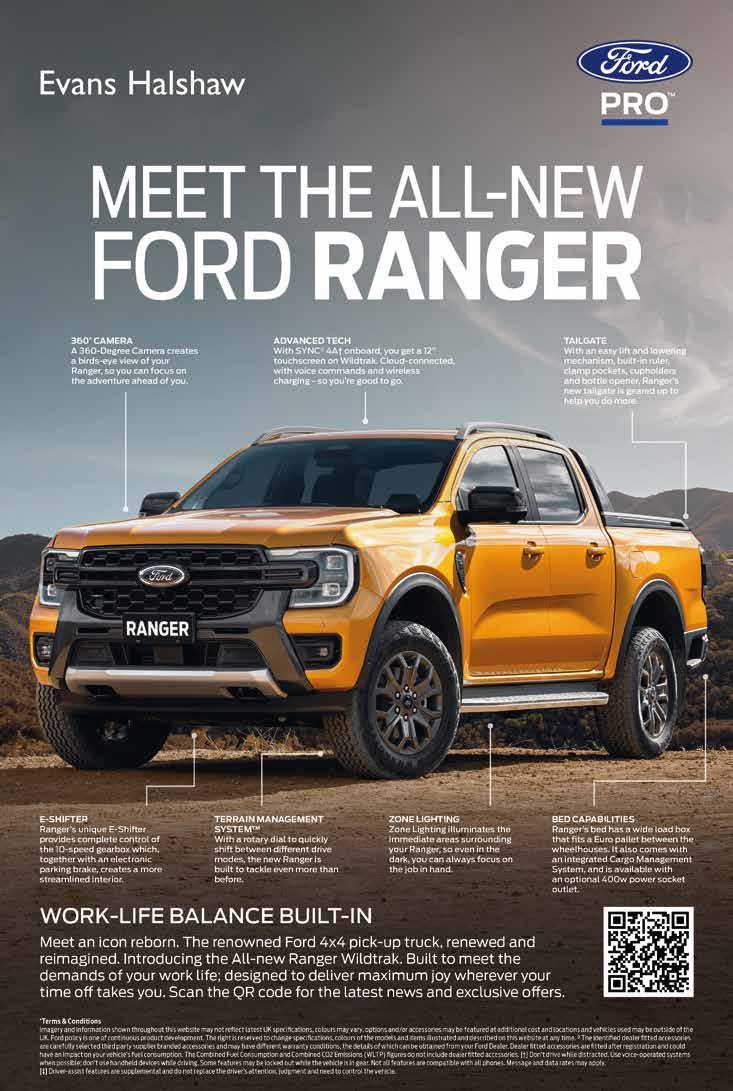
































































 Andrew Walker
Andrew Walker



































